This is “Linear Equations and Inequalities”, chapter 2 from the book Beginning Algebra (v. 1.0). For details on it (including licensing), click here.
For more information on the source of this book, or why it is available for free, please see the project's home page. You can browse or download additional books there. To download a .zip file containing this book to use offline, simply click here.
Chapter 2 Linear Equations and Inequalities
2.1 Introduction to Algebra
Learning Objectives
- Identify an algebraic expression and its parts.
- Evaluate algebraic expressions.
- Use formulas to solve problems in common applications.
Preliminary Definitions
In algebra, letters are used to represent numbers. The letters used to represent these numbers are called variablesLetters or symbols used in algebra to represent numbers.. Combinations of variables and numbers along with mathematical operations form algebraic expressionsCombinations of variables and numbers along with mathematical operations used to generalize specific arithmetic operations., or just expressions. The following are some examples of expressions with one variable, x:

TermsComponents of an algebraic expression separated by addition operators. in an algebraic expression are separated by addition operators, and factorsAny of the numbers or expressions that form a product. are separated by multiplication operators. The numerical factor of a term is called the coefficientThe numerical factor of a term.. For example, the algebraic expression can be thought of as and has three terms. The first term, , represents the quantity , where 3 is the coefficient and x is the variable. All of the variable factors, with their exponents, form the variable part of a termAll the variable factors with their exponents.. If a term is written without a variable factor, then it is called a constant termA term written without a variable factor.. Consider the components of ,
| Terms | Coefficient | Variable Part |
|---|---|---|
| 3 | ||
| 2 | ||
| −1 | −1 |
The third term in this expression, −1, is a constant term because it is written without a variable factor. While a variable represents an unknown quantity and may change, the constant term does not change.
Example 1: List all coefficients and variable parts of each term: .
Solution: Think of the third term in this example, , as .
| Terms | Coefficient | Variable Part |
|---|---|---|
| 5 | ||
| −4 | ||
| −1 |
Answer: Coefficients: ; variable parts:
Some terms, such as and , appear not to have a coefficient. The multiplicative identity property states that 1 times anything is itself and occurs so often that it is customary to omit this factor and write

Therefore, the coefficient of is actually 1 and the coefficient of is −1. In addition, you will encounter terms that have variable parts composed of algebraic expressions as factors.
Example 2: List all coefficients and variable parts of each term: .
Solution: This is an expression with two terms:
| Terms | Coefficient | Variable Part |
|---|---|---|
| −3 | ||
| 1 |
Answer: Coefficients: ; variable parts:
In our study of algebra, we will encounter a wide variety of algebraic expressions. Typically, expressions use the two most common variables, x and y. However, expressions may use any letter (or symbol) for a variable, even Greek letters, such as alpha () and beta (). Some letters and symbols are reserved for constants, such as and . Since there is only a limited number of letters, you will also use subscripts, , to indicate different variables.
Try this! List all coefficients and variable parts of the expression: .
Answer: Coefficients: ; variable parts:
Video Solution
(click to see video)Evaluating Algebraic Expressions
Think of an algebraic expression as a generalization of particular arithmetic operations. Performing these operations after substituting given values for variables is called evaluatingThe process of performing the operations of an algebraic expression for given values of the variables.. In algebra, a variable represents an unknown value. However, if the problem specifically assigns a value to a variable, then you can replace that letter with the given number and evaluate using the order of operations.
Example 3: Evaluate:
a. , where
b. , where
Solution: To avoid common errors, it is a best practice to first replace all variables with parentheses and then replace, or substituteThe act of replacing a variable with an equivalent quantity., the given value.
a.

b.

Answers: a. −5; b. 6
If parentheses are not used in part (a) of the previous example, the result is quite different: . Without parentheses, the first operation is subtraction, which leads to an incorrect result.
Example 4: Evaluate: , where and .
Solution: After substituting the given values for the variables, simplify using the order of operations.

Answer: 13
Example 5: Evaluate: , where and .
Solution:

Answer: 11
Example 6: Evaluate: , where .
Solution:
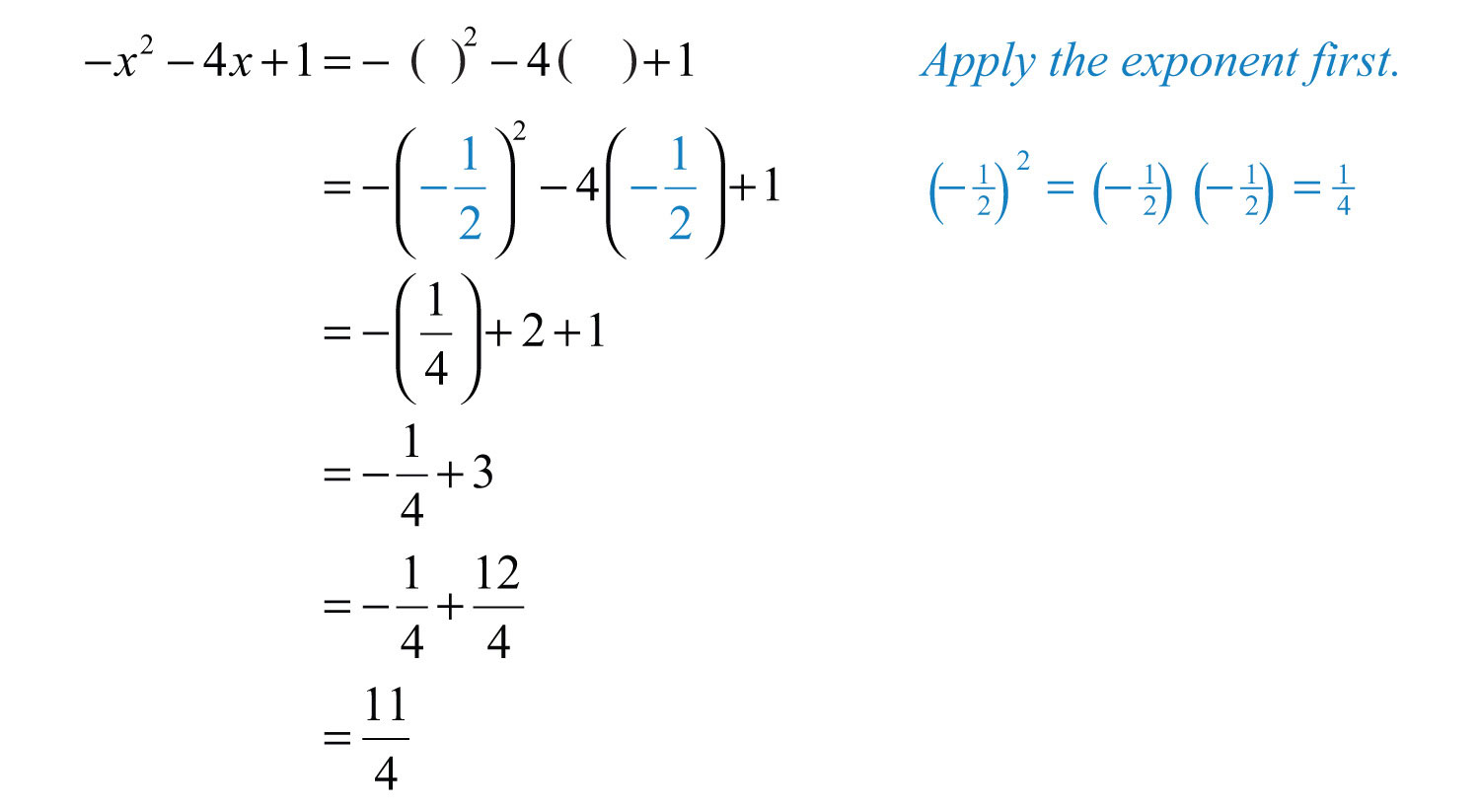
Answer: 11/4
The answer to the previous example is , which can be written as a mixed number . In algebra, improper fractions are generally preferred. Unless the original problem has mixed numbers in it, or it is an answer to a real-world application, solutions will be expressed as reduced improper fractions.
Example 7: Evaluate: , where .
Solution: The order of operations requires us to perform the operations within the parentheses first.
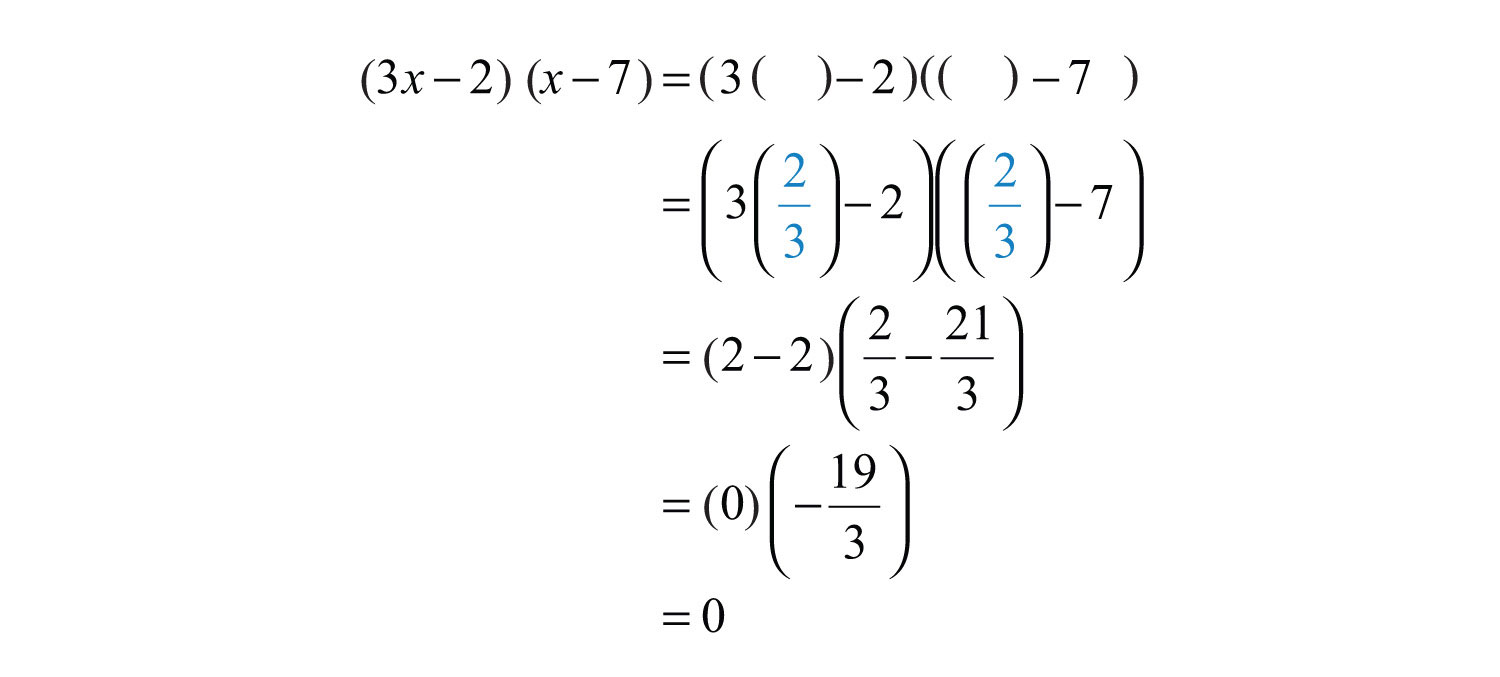
Answer: 0
Example 8: Evaluate: , where , , and .
Solution: The expression is called the discriminantThe algebraic expression .; it is an essential quantity seen later in our study of algebra.

Answer: 17
Try this! Evaluate , where and .
Answer: 35
Video Solution
(click to see video)Using Formulas
The main difference between algebra and arithmetic is the organized use of variables. This idea leads to reusable formulasA reusable mathematical model using algebraic expressions to describe a common application., which are mathematical models using algebraic expressions to describe common applications. For example, the area of a rectangle is modeled by the formula:

In this equation, variables are used to describe the relationship between the area of a rectangle and the length of its sides. The area is the product of the length and width of the rectangle. If the length of a rectangle measures 3 meters and the width measures 2 meters, then the area can be calculated using the formula as follows:

Example 9: The cost of a daily truck rental is $48.00 plus an additional $0.45 for every mile driven. This cost in dollars can be modeled by the formula , where x represents the number of miles driven in one day. Use this formula to calculate the cost to rent the truck for a day and drive it 120 miles.
Solution: Use the formula to find the cost when the number of miles .

Substitute 120 into the given formula for x and then simplify.

Answer: The rental costs $102.
Uniform motionDescribed by the formula , where the distance D is given as the product of the average rate r and the time t traveled at that rate. is modeled by the formula , which expresses distance D in terms of the average rate r, or speed, and the time t traveled at that rate. This formula, , is used often and is read “distance equals rate times time.”
Example 10: Jim’s road trip takes hours at an average speed of 66 miles per hour. How far does he travel?
Solution: Substitute the appropriate values into the formula and then simplify.

Answer: Jim travels 165 miles.
The volume in cubic units of a rectangular box is given by the formula , where l represents the length, w represents the width, and h represents the height.

Example 11: A wooden box is 1 foot in length, 5 inches wide, and 6 inches high. Find the volume of the box in cubic inches.
Solution: Take care to ensure that all the units are consistent and use 12 inches for the length instead of 1 foot.

Answer: The volume of the box is 360 cubic inches.
Simple interestModeled by the formula , where p represents the principal amount invested at an annual interest rate r for t years. is given by the formula , where p represents the principal amount invested at an annual interest rate r for t years.
Example 12: Calculate the simple interest earned on a 2-year investment of $1,250 at an annual interest rate of .
Solution: Convert to a decimal number before using it in the formula.

Use this value for r and the fact that p = $1,250 and t = 2 years to calculate the simple interest.

Answer: The simple interest earned is $93.75.
Try this! The perimeter of a rectangle is given by the formula , where l represents the length and w represents the width. Use the formula to calculate the perimeter of a rectangle with a length of 5 feet and a width of feet.
Answer: 15 feet
Video Solution
(click to see video)Key Takeaways
- Think of algebraic expressions as generalizations of common arithmetic operations that are formed by combining numbers, variables, and mathematical operations.
- It is customary to omit the coefficient if it is 1, as in .
- To avoid common errors when evaluating, it is a best practice to replace all variables with parentheses and then substitute the appropriate values.
- The use of algebraic expressions allows us to create useful and reusable formulas that model common applications.
Topic Exercises
Part A: Definitions
List all of the coefficients and variable parts of the following expressions.
1.
2.
3.
4.
5.
6.
7.
8.
9.
10.
Part B: Evaluating Algebraic Expressions
Evaluate.
11. , where
12. , where
13. , where
14. , where
15. , where
16. , where
17. , where
18. , where
19. , where
20. , where
21. , where
22. , where
For each problem below, evaluate , given the following values for a, b, and c.
23. , ,
24. , ,
25. , ,
26. , ,
27. , ,
28. , ,
Evaluate.
29. , where and
30. , where and
31. , where and .
32. , where and
33. , where and
34. , where
35. , where
36. , where
37. , where
38. , where
39. , where and
40. , where and
41. Evaluate , given and .
42. Evaluate , given and .
43. Evaluate , given and .
44. Evaluate , given and .
Part C: Using Formulas
Convert the following temperatures to degrees Celsius given , where F represents degrees Fahrenheit.
45. 86°F
46. 95°F
47. −13°F
48. 14°F
49. 32°F
50. 0°F
Given the base and height of a triangle, calculate the area. ()
51. centimeters and centimeters
52. inches and inches
53. foot and feet
54. inches and inches
55. A certain cellular phone plan charges $23.00 per month plus $0.09 for each minute of usage. The monthly charge is given by the formula , where x represents the number of minutes of usage per month. What is the charge for a month with 5 hours of usage?
56. A taxi service charges $3.75 plus $1.15 per mile given by the formula , where x represents the number of miles driven. What is the charge for a 17-mile ride?
57. If a calculator is sold for $14.95, then the revenue in dollars, R, generated by this item is given by the formula , where q represents the number of calculators sold. Use the formula to determine the revenue generated by this item if 35 calculators are sold.
58. Yearly subscriptions to a tutoring website can be sold for $49.95. The revenue in dollars, R, generated by subscription sales is given by the formula , where q represents the number of yearly subscriptions sold. Use the formula to calculate the revenue generated by selling 250 subscriptions.
59. The cost of producing pens with the company logo printed on them consists of a onetime setup fee of $175 plus $0.85 for each pen produced. This cost can be calculated using the formula , where q represents the number of pens produced. Use the formula to calculate the cost of producing 2,000 pens.
60. The cost of producing a subscription website consists of an initial programming and setup fee of $4,500 plus a monthly Web hosting fee of $29.95. The cost of creating and hosting the website can be calculated using the formula , where n represents the number of months the website is hosted. How much will it cost to set up and host the website for 1 year?
61. The perimeter of a rectangle is given by the formula , where l represents the length and w represents the width. What is the perimeter of a fenced-in rectangular yard measuring 70 feet by 100 feet?
62. Calculate the perimeter of an 8-by-10-inch picture.
63. Calculate the perimeter of a room that measures 12 feet by 18 feet.
64. A computer monitor measures 57.3 centimeters in length and 40.9 centimeters high. Calculate the perimeter.
65. The formula for the area of a rectangle in square units is given by , where l represents the length and w represents the width. Use this formula to calculate the area of a rectangle with length 12 centimeters and width 3 centimeters.
66. Calculate the area of an 8-by-12-inch picture.
67. Calculate the area of a room that measures 12 feet by 18 feet.
68. A computer monitor measures 57.3 centimeters in length and 40.9 centimeters in height. Calculate the total area of the screen.
69. A concrete slab is poured in the shape of a rectangle for a shed measuring 8 feet by 10 feet. Determine the area and perimeter of the slab.
70. Each side of a square deck measures 8 feet. Determine the area and perimeter of the deck.
71. The volume of a rectangular solid is given by , where l represents the length, w represents the width, and h is the height of the solid. Find the volume of a rectangular solid if the length is 2 inches, the width is 3 inches, and the height is 4 inches.
72. If a trunk measures 3 feet by 2 feet and is 2½ feet tall, then what is the volume of the trunk?
73. The interior of an industrial freezer measures 3 feet wide by 3 feet deep and 4 feet high. What is the volume of the freezer?
74. A laptop case measures 1 feet 2 inches by 10 inches by 2 inches. What is the volume of the case?
75. If the trip from Fresno to Sacramento can be made by car in 2½ hours at an average speed of 67 miles per hour, then how far is Sacramento from Fresno?
76. A high-speed train averages 170 miles per hour. How far can it travel in 1½ hours?
77. A jumbo jet can cruises at an average speed of 550 miles per hour. How far can it travel in 4 hours?
78. A fighter jet reaches a top speed of 1,316 miles per hour. How far will the jet travel if it can sustain this speed for 15 minutes?
79. The Hubble Space Telescope is in low earth orbit traveling at an average speed of 16,950 miles per hour. What distance does it travel in 1½ hours?
80. Earth orbits the sun a speed of about 66,600 miles per hour. How far does earth travel around the sun in 1 day?
81. Calculate the simple interest earned on a $2,500 investment at 3% annual interest rate for 4 years.
82. Calculate the simple interest earned on a $1,000 investment at 5% annual interest rate for 20 years.
83. How much simple interest is earned on a $3,200 investment at a 2.4% annual interest for 1 year?
84. How much simple interest is earned on a $500 investment at a 5.9% annual interest rate for 3 years?
85. Calculate the simple interest earned on a $10,500 investment at a annual interest rate for 4 years.
86. Calculate the simple interest earned on a $6,250 investment at a annual interest rate for 1 year.
Part D: Discussion Board Topics
87. Research and discuss the history of the symbols for addition (+) and subtraction (−).
88. What are mathematical models and why are they useful in everyday life?
89. Find and post a useful formula. Demonstrate its use with some values.
90. Discuss the history and importance of the variable. How can you denote a variable when you run out of letters?
91. Find and post a useful resource describing the Greek alphabet.
Answers
1: Coefficients: ; variable parts:
3: Coefficients: ; variable parts:
5: Coefficients: ; variable parts:
7: Coefficients: ; variable parts:
9: Coefficients: ; variable parts:
11: −1
13: 0
15: 24
17: 90
19: 5/3
21: 5/2
23: −8
25: −48
27: 19/12
29: 48
31: −5
33: 0
35: −6
37: 6
39: −17
41: 20.04
43: 1.32
45: 30°C
47: −25°C
49: 0°C
51: 125 square centimeters
53: 1/2 square feet
55: $50
57: $523.25
59: $1,875.00
61: 340 feet
63: 60 feet
65: 36 square centimeters
67: 216 square feet
69: Area: 80 square feet; Perimeter: 36 feet
71: 24 cubic inches
73: 36 cubic feet
75: 167.5 miles
77: 2,200 miles
79: 25,425 miles
81: $300
83: $76.80
85: $1,785
2.2 Simplifying Algebraic Expressions
Learning Objectives
- Apply the distributive property to simplify an algebraic expression.
- Identify and combine like terms.
Distributive Property
The properties of real numbers are important in our study of algebra because a variable is simply a letter that represents a real number. In particular, the distributive propertyGiven any real numbers a, b, and c, or . states that given any real numbers a, b, and c,

This property is applied when simplifying algebraic expressions. To demonstrate how it is used, we simplify in two ways, and observe the same correct result.

Certainly, if the contents of the parentheses can be simplified, do that first. On the other hand, when the contents of parentheses cannot be simplified, multiply every term within the parentheses by the factor outside of the parentheses using the distributive property. Applying the distributive property allows you to multiply and remove the parentheses.
Example 1: Simplify: .
Solution: Multiply 5 times each term inside the parentheses.

Answer:
Example 2: Simplify: .
Solution: Multiply −3 times each of the coefficients of the terms inside the parentheses.

Answer:
Example 3: Simplify: .
Solution: Apply the distributive property by multiplying only the terms grouped within the parentheses by 5.

Answer:
Because multiplication is commutative, we can also write the distributive property in the following manner: .
Example 4: Simplify: .
Solution: Multiply each term within the parentheses by 3.

Answer:
Division in algebra is often indicated using the fraction bar rather than with the symbol (÷). And sometimes it is useful to rewrite expressions involving division as products:
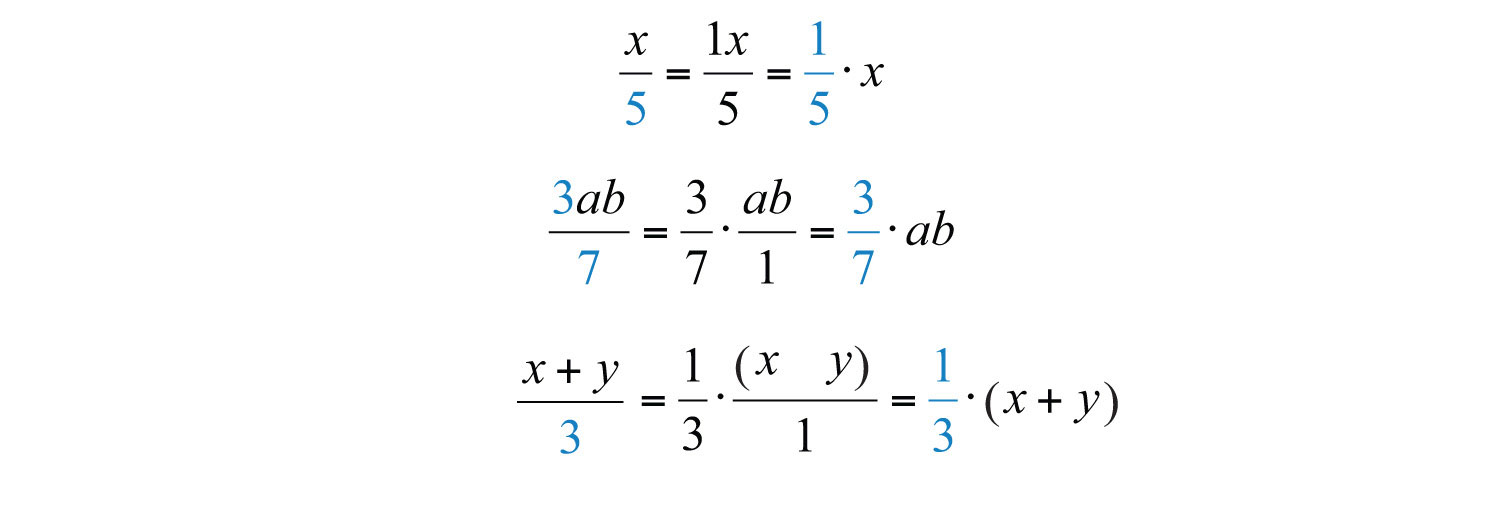
Rewriting algebraic expressions as products allows us to apply the distributive property.
Example 5: Divide: .
Solution: First, treat this as times the expression in the numerator and then distribute.
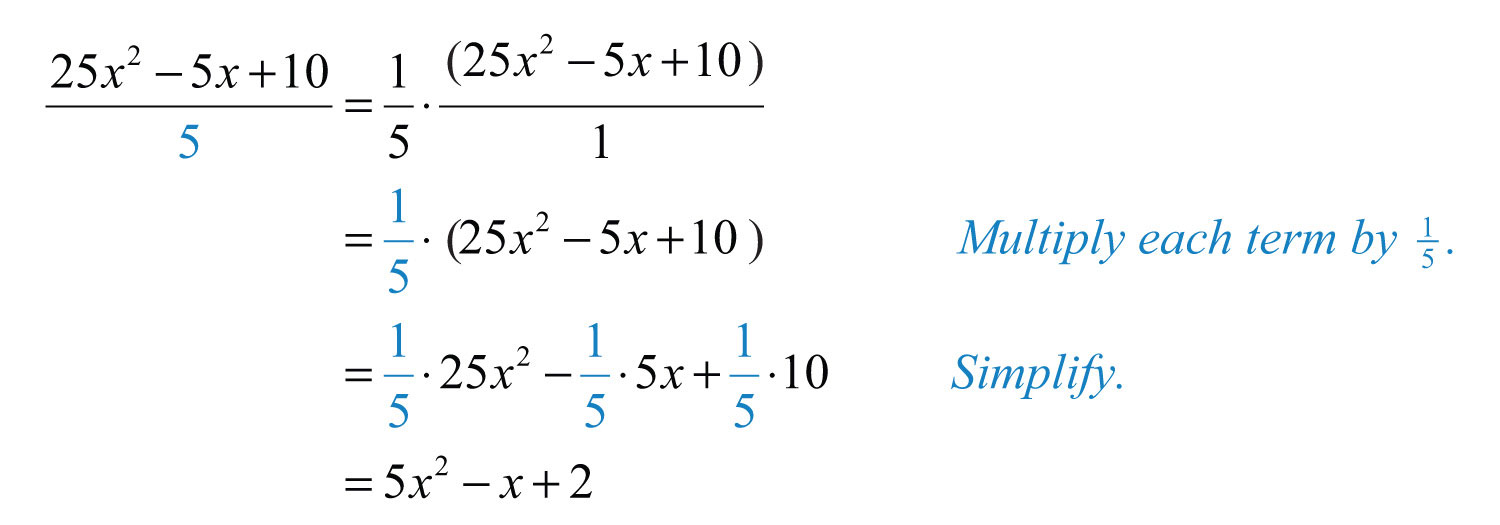
Alternate Solution: Think of 5 as a common denominator and divide each of the terms in the numerator by 5:

Answer:
We will discuss the division of algebraic expressions in more detail as we progress through the course.
Try this! Simplify: .
Answer:
Video Solution
(click to see video)Combining Like Terms
Terms with the same variable parts are called like termsConstant terms or terms with the same variable parts., or similar termsUsed when referring to like terms.. Furthermore, constant terms are considered to be like terms. If an algebraic expression contains like terms, apply the distributive property as follows:

In other words, if the variable parts of terms are exactly the same, then we may add or subtract the coefficients to obtain the coefficient of a single term with the same variable part. This process is called combining like termsAdding or subtracting like terms within an algebraic expression to obtain a single term with the same variable part.. For example,

Notice that the variable factors and their exponents do not change. Combining like terms in this manner, so that the expression contains no other similar terms, is called simplifying the expressionThe process of combining like terms until the expression contains no more similar terms.. Use this idea to simplify algebraic expressions with multiple like terms.
Example 6: Simplify: .
Solution: Identify the like terms and combine them.

Answer:
In the previous example, rearranging the terms is typically performed mentally and is not shown in the presentation of the solution.
Example 7: Simplify: .
Solution: Identify the like terms and add the corresponding coefficients.

Answer:
Example 8: Simplify: .
Solution: Remember to leave the variable factors and their exponents unchanged in the resulting combined term.

Answer:
Example 9: Simplify: .
Solution: To add the fractional coefficients, use equivalent coefficients with common denominators for each like term.

Answer:
Example 10: Simplify: .
Solution: Consider the variable part to be . Then this expression has two like terms with coefficients −12 and 26.

Answer:
Try this! Simplify: .
Answer:
Video Solution
(click to see video)Distributive Property and Like Terms
When simplifying, we will often have to combine like terms after we apply the distributive property. This step is consistent with the order of operations: multiplication before addition.
Example 11: Simplify: .
Solution: Distribute 2 and −7 and then combine like terms.

Answer:
In the example above, it is important to point out that you can remove the parentheses and collect like terms because you multiply the second quantity by −7, not just by 7. To correctly apply the distributive property, think of this as adding −7 times the given quantity, .
Try this! Simplify: .
Answer:
Video Solution
(click to see video)Often we will encounter algebraic expressions like or . As we have seen, the coefficients are actually implied to be +1 and −1, respectively, and therefore, the distributive property applies using +1 or –1 as the factor. Multiply each term within the parentheses by these factors:

This leads to two useful properties,

Example 12: Simplify: .
Solution: Multiply each term within the parentheses by −1 and then combine like terms.

Answer:
When distributing a negative number, all of the signs within the parentheses will change. Note that in the example above is a separate term; hence the distributive property does not apply to it.
Example 13: Simplify: .
Solution: The order of operations requires that we multiply before subtracting. Therefore, distribute −2 and then combine the constant terms. Subtracting 5 − 2 first leads to an incorrect result, as illustrated below:

Answer: −2x2 + 8x + 11
Caution
It is worth repeating that you must follow the order of operations: multiply and divide before adding and subtracting!
Try this! Simplify: .
Answer:
Video Solution
(click to see video)
Example 14: Subtract from twice the quantity .
Solution: First, group each expression and treat each as a quantity:

Next, identify the key words and translate them into a mathematical expression.

Finally, simplify the resulting expression.

Answer:
Key Takeaways
- The properties of real numbers apply to algebraic expressions, because variables are simply representations of unknown real numbers.
- Combine like terms, or terms with the same variable part, to simplify expressions.
- Use the distributive property when multiplying grouped algebraic expressions, .
- It is a best practice to apply the distributive property only when the expression within the grouping is completely simplified.
- After applying the distributive property, eliminate the parentheses and then combine any like terms.
- Always use the order of operations when simplifying.
Topic Exercises
Part A: Distributive Property
Multiply.
1.
2.
3.
4.
5.
6.
7.
8.
9.
10.
11.
12.
13.
14.
15.
16.
17.
18.
19.
20.
21.
22.
23.
24.
25.
26.
27.
28.
29.
30.
Translate the following sentences into algebraic expressions and then simplify.
31. Simplify two times the expression .
32. Simplify the opposite of the expression .
33. Simplify the product of 5 and .
34. Simplify the product of −3 and .
Part B: Combining Like Terms
Simplify.
35.
36.
37.
38.
39.
40.
41.
42.
43.
44.
45.
46.
47.
48.
49.
50.
51.
52.
53.
54.
55.
56.
57.
58.
59.
60.
61.
62.
63.
64.
65.
66.
Part C: Mixed Practice
Simplify.
67.
68.
69.
70.
71.
72.
73.
74.
75.
76.
77.
78.
79.
80.
81.
82.
83.
84.
85.
86.
87.
88.
89.
90.
91.
92.
93.
94.
95.
96.
Translate the following sentences into algebraic expressions and then simplify.
97. What is the difference of and ?
98. Subtract from .
99. Subtract from twice the quantity .
100. Subtract three times the quantity from .
Part D: Discussion Board Topics
101. Do we need a distributive property for division, ? Explain.
102. Do we need a separate distributive property for three terms, ? Explain.
103. Explain how to subtract one expression from another. Give some examples and demonstrate the importance of the order in which subtraction is performed.
104. Given the algebraic expression , explain why subtracting is not the first step.
105. Can you apply the distributive property to the expression ? Explain why or why not and give some examples.
106. How can you check to see if you have simplified an expression correctly? Give some examples.
Answers
1:
3:
5:
7:
9:
11:
13:
15:
17:
19:
21:
23:
25:
27:
29:
31:
33:
35:
37:
39:
41:
43:
45:
47:
49:
51:
53:
55:
57:
59:
61:
63:
65:
67:
69:
71:
73:
75:
77:
79:
81:
83:
85:
87:
89:
91:
93:
95:
97:
99:
2.3 Solving Linear Equations: Part I
Learning Objectives
- Identify linear equations with one variable and verify their solutions.
- Use the properties of equality to solve basic linear equations.
- Use multiple steps to solve linear equations by isolating the variable.
- Solve linear equations where the coefficients are fractions or decimals.
Linear Equations with One Variable and Their Solutions
Learning how to solve various algebraic equations is one of the main goals in algebra. This section introduces the basic techniques used for solving linear equations with one variable.
An equationStatement indicating that two algebraic expressions are equal. is a statement indicating that two algebraic expressions are equal. A linear equation with one variableAn equation that can be written in the general form , where a and b are real numbers and ., x, is an equation that can be written in the general form , where a and b are real numbers and . Here are some examples of linear equations, all of which are solved in this section:

A solutionAny value that can replace the variable in an equation to produce a true statement. to a linear equation is any value that can replace the variable to produce a true statement. The variable in the linear equation is x, and the solution is . To verify this, substitute the value 5 for x and check that you obtain a true statement.

Alternatively, when an equation is equal to a constant, we can verify a solution by substituting the value for the variable and show that the result is equal to that constant. In this sense, we say that solutions satisfy the equationAfter replacing the variable with a solution and simplifying, it produces a true statement..
Example 1: Is a solution to ?

Answer: Yes, it is a solution, because satisfies the equation.
Example 2: Is a solution to ?

Answer: No, it is not a solution, because does not satisfy the equation.
Recall that when evaluating expressions, it is a good practice to first replace all variables with parentheses, then substitute the appropriate values. By making use of parentheses we avoid some common errors when working the order of operations.
Example 3: Is a solution to ?
Solution:
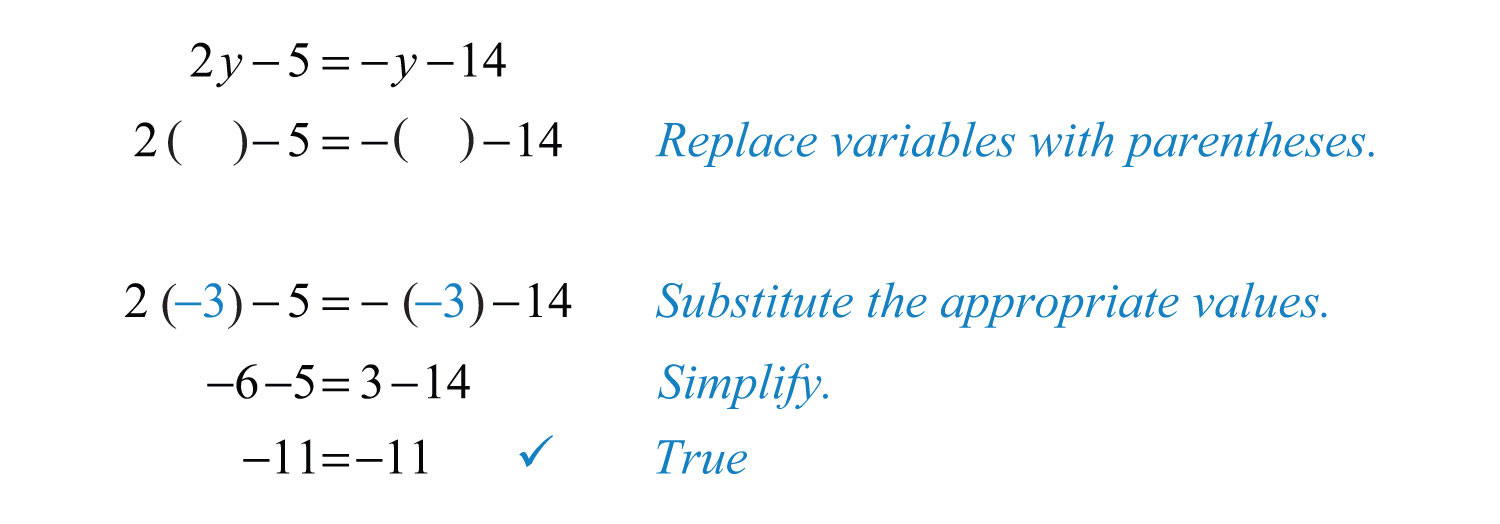
Answer: Yes, it is a solution, because produces a true statement.
Try this! Is a solution to ?
Answer: No
Video Solution
(click to see video)Solving Basic Linear Equations
We begin by defining equivalent equationsEquations with the same solution set. as equations with the same solution set. Consider the following two linear equations and check to see if the solution is .

Here we can see that the two linear equations and are equivalent because they share the same solution set, namely, {7}. The goal is to develop a systematic process to find equivalent equations until the variable is isolated:

To do this, use the properties of equalityProperties that allow us to obtain equivalent equations by adding, subtracting, multiplying, and dividing both sides of an equation by nonzero real numbers.. Given algebraic expressions A and B, where c is a real number, we have the following:

Note
Multiplying or dividing both sides of an equation by 0 is carefully avoided. Dividing by 0 is undefined and multiplying both sides by 0 results in the equation 0 = 0.
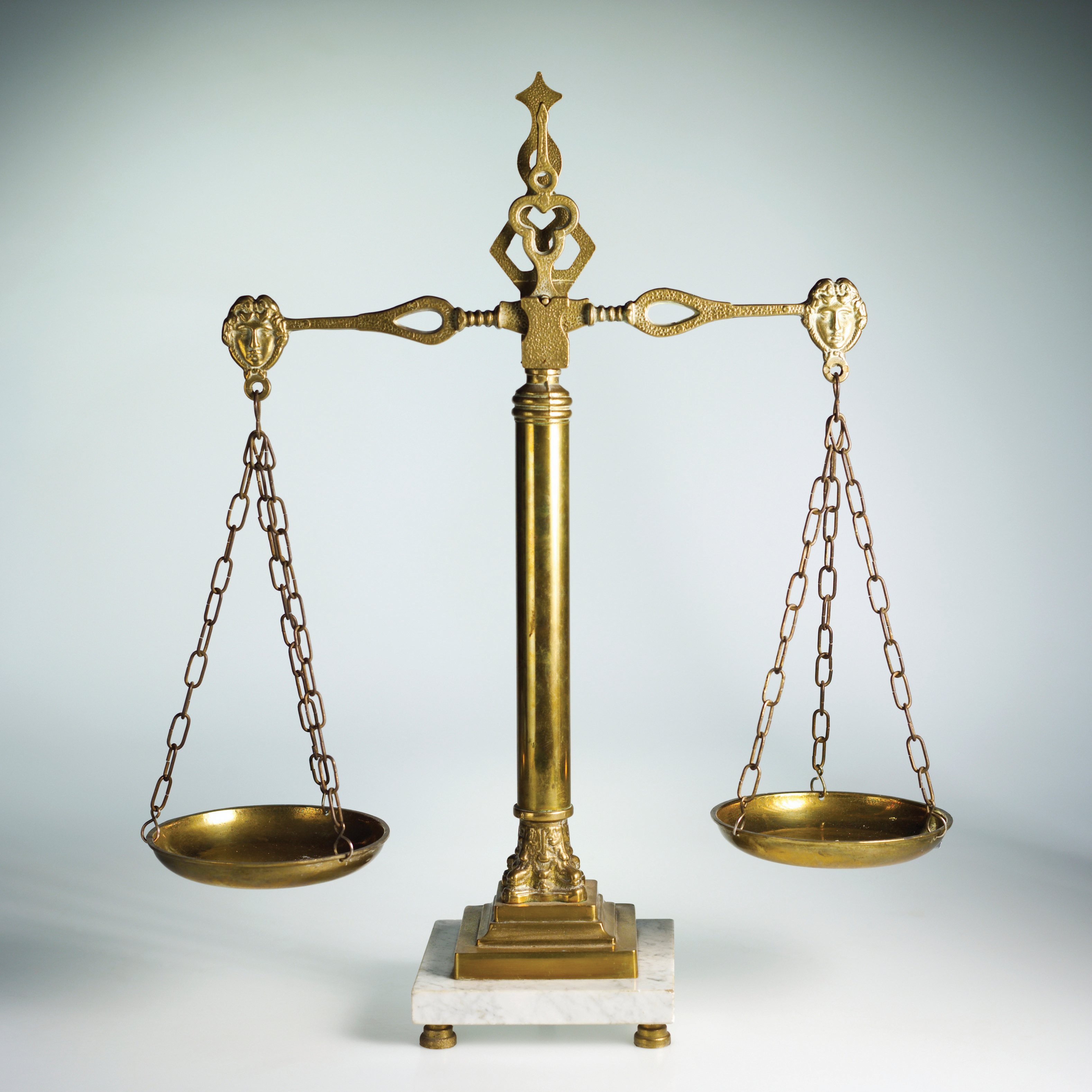
To summarize, equality is retained and you obtain an equivalent equation if you add, subtract, multiply, or divide both sides of an equation by any nonzero real number. The technique for solving linear equations involves applying these properties in order to isolate the variable on one side of the equation. If the linear equation has a constant term, then we add to or subtract it from both sides of the equation to obtain an equivalent equation where the variable term is isolated.
Example 4: Solve: .
Solution: To isolate the variable x on the left side, subtract 3 from both sides.

Answer: The solution is . To check that this is true, substitute −8 into the original equation and simplify to see that it is satisfied: ✓.
In the previous example, after subtracting 3 from both sides, you get . By the additive identity property of real numbers, this is equivalent to . This step is often left out in the presentation of the solution.
If the variable term of the equation (including the coefficient) is isolated, then apply the multiplication or division property of equality to obtain an equivalent equation with the variable isolated. In other words, our goal is to obtain an equivalent equation with x or 1x isolated on one side of the equal sign.
Example 5: Solve: .
Solution: The coefficient of x is –5, so divide both sides by −5.

Answer: The solution is . Perform the check mentally by substituting 7 for x in the original equation.
In the previous example, after dividing both sides by −5, x is left with a coefficient of 1, because . In fact, when we say “isolate the variable,” we mean to change the coefficient of the variable to 1, because is equivalent to . This step is often left out of the instructional examples even though its omission is sometimes a source of confusion.
Another important property is the symmetric propertyAllows you to solve for the variable on either side of the equal sign, because is equivalent to .: for any algebraic expressions A and B,

The equation is equivalent to . It does not matter on which side we choose to isolate the variable.
Example 6: Solve: .
Solution: Isolate the variable x by subtracting 5 from both sides of the equation.

Answer: The solution is −3, and checking the solution shows that 2 = 5 − 3.
Try this! Solve: .
Answer:
Video Solution
(click to see video)Isolating the Variable in Two Steps
A linear equation of the form takes two steps to solve. First, use the appropriate equality property of addition or subtraction to isolate the variable term. Next, isolate the variable using the equality property of multiplication or division. Checking solutions in the following examples is left to the reader.
Example 7: Solve: .
Solution:

Answer: The solution is 10.
Example 8: Solve: .
Solution:
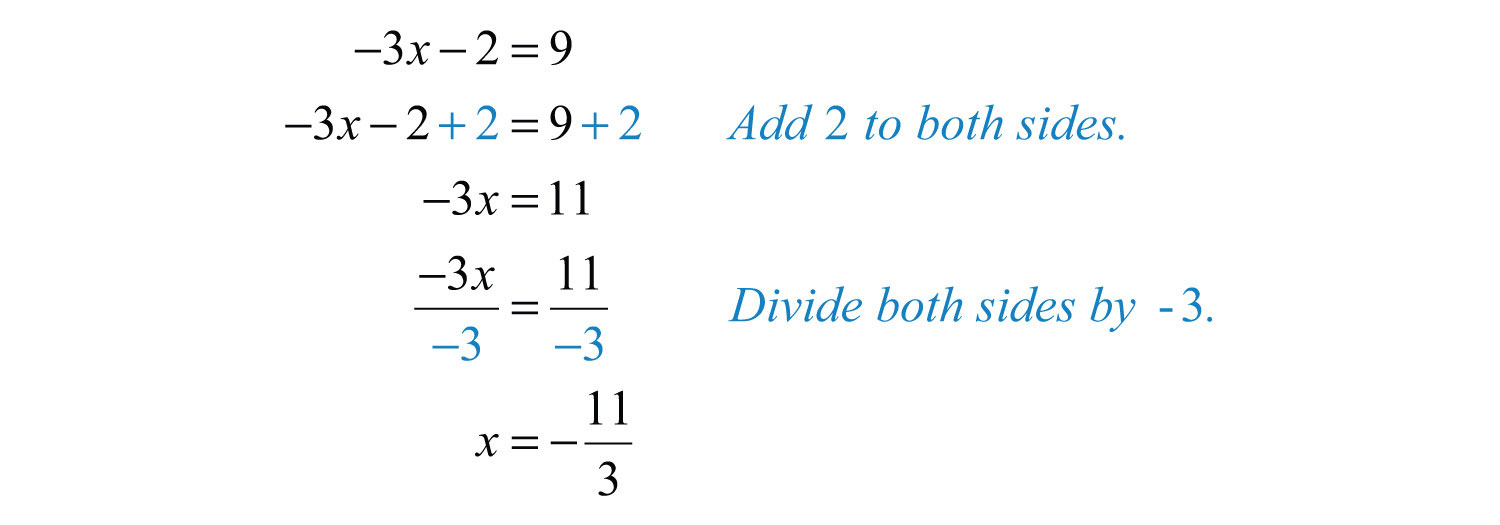
Answer: The solution is .
Example 9: Solve: .
Solution: When no sign precedes the term, it is understood to be positive. In other words, think of this as . Begin by subtracting 6 from both sides of the equal sign.

Answer: The solution is 4.
Example 10: Solve: .
Solution:
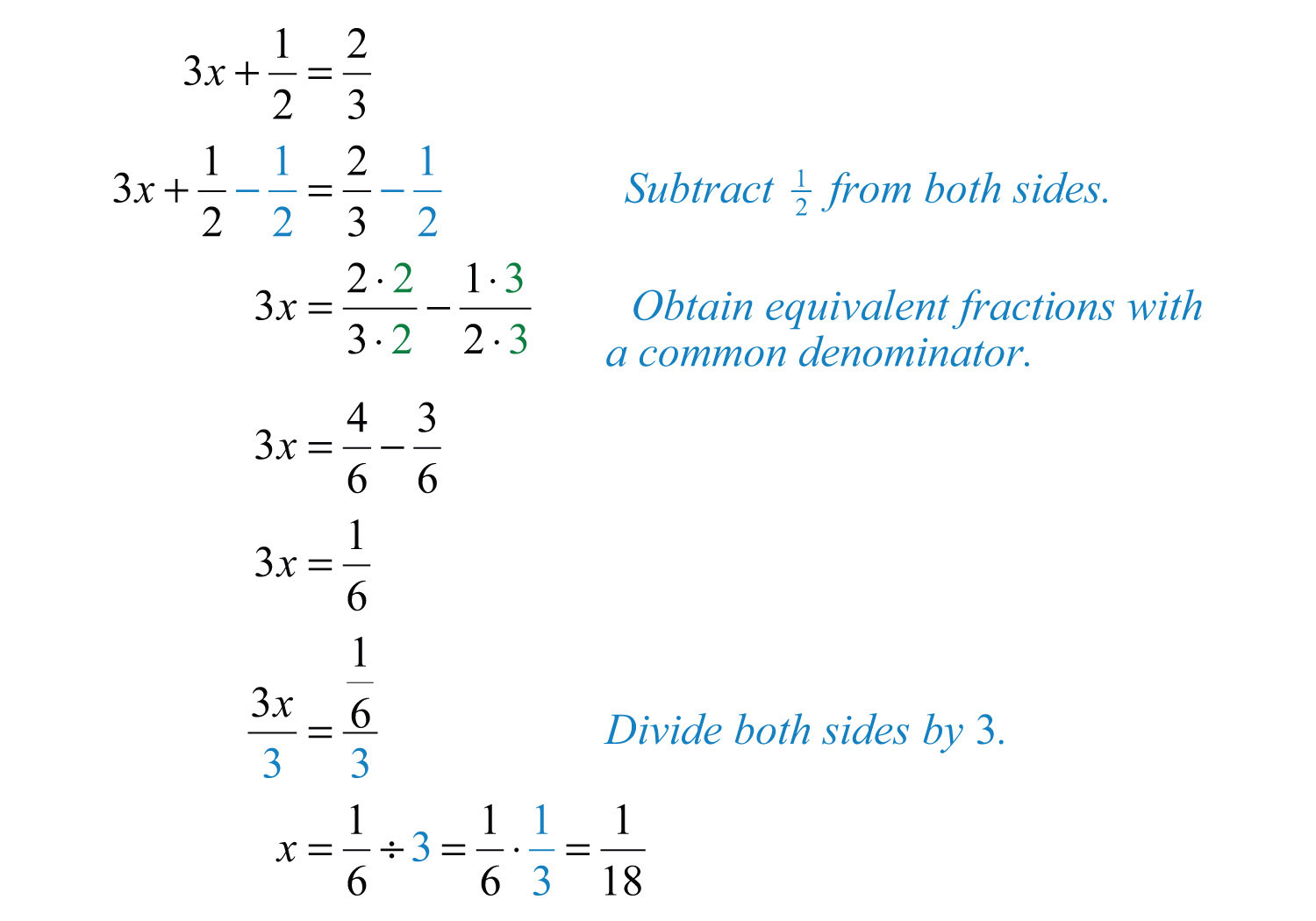
Answer: The solution is .
Example 11: Solve: .
Solution:

Recall that is equivalent to ; divide both sides of the equation by −1.

Alternatively, multiply both sides of by −1 and achieve the same result:

Answer: The solution is 2.
In summary, to retain equivalent equations, we must perform the same operation on both sides of the equation. First, apply the addition or subtraction property of equality to isolate the variable term and then apply the multiplication or division property of equality to isolate the variable on one side of the equation.
Try this! Solve: .
Answer:
Video Solution
(click to see video)Multiplying by the Reciprocal
To solve an equation like , we can isolate the variable by dividing both sides by the coefficient. For example,
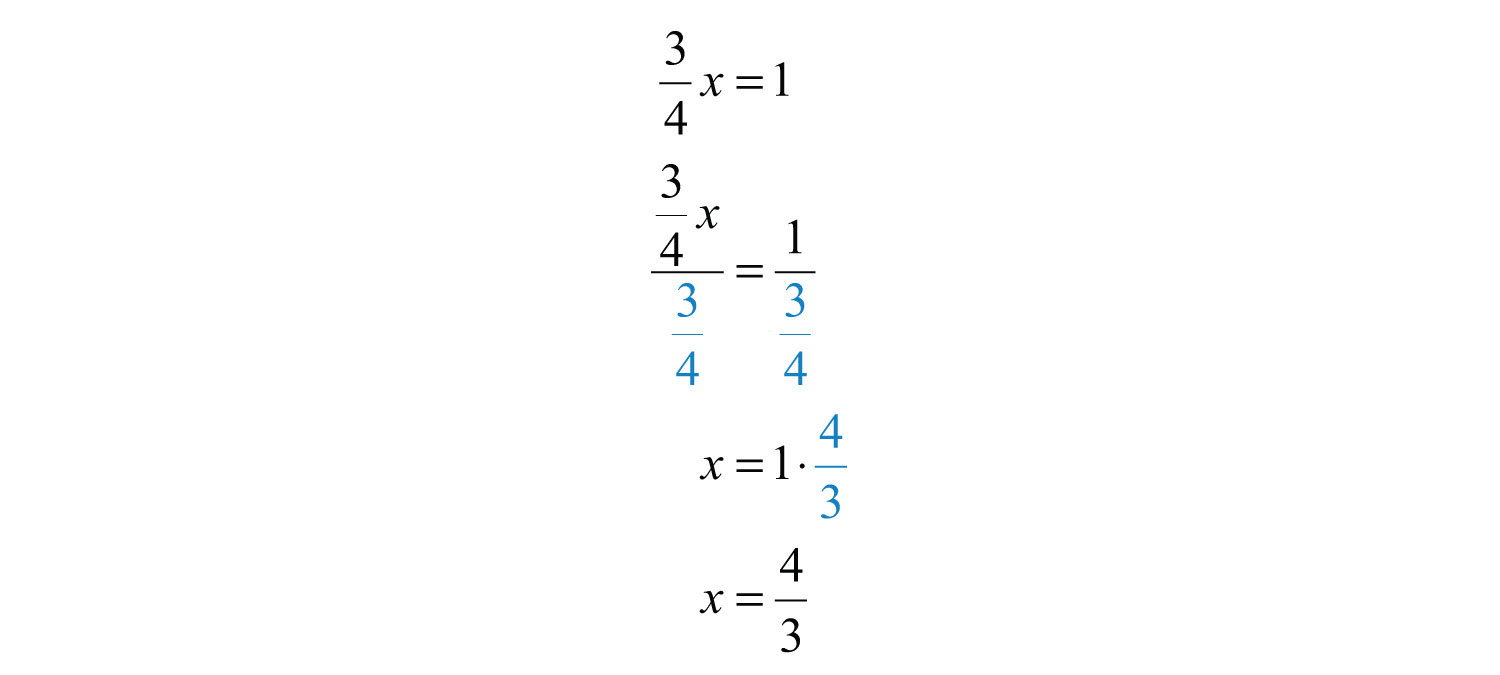
On the left side of the equal sign, the fraction cancels. On the right side, we have a complex fraction and multiply by the reciprocal of the coefficient. You can save a step by recognizing this and start by multiplying both sides of the equation by the reciprocal of the coefficient.

Recall that the product of reciprocals is 1, in this case , leaving the variable isolated.
Example 12: Solve: .
Solution: Isolate the variable term using the addition property of equality and then multiply both sides of the equation by the reciprocal of the coefficient .
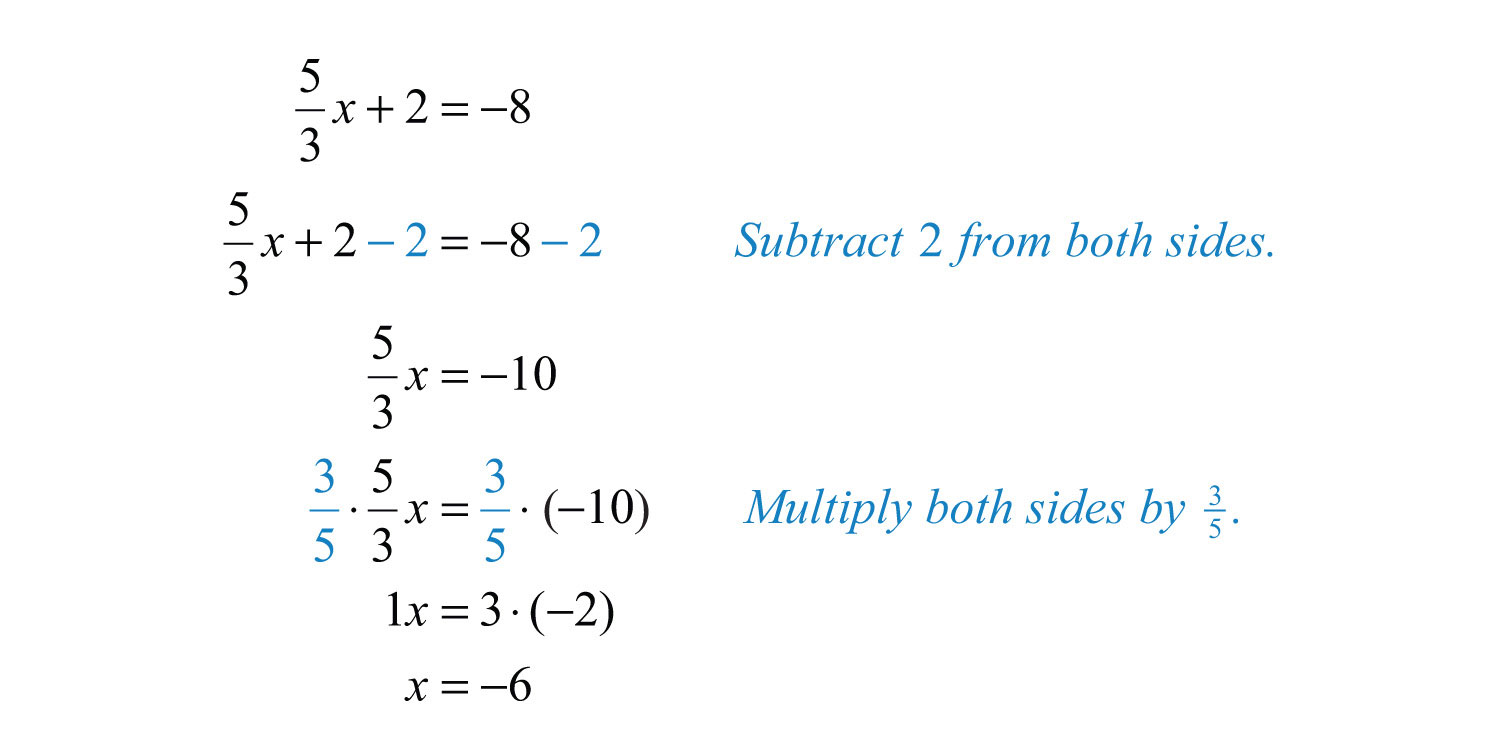
Answer: The solution is −6.
Example 13: Solve: .
Solution:

The reciprocal of is because . Therefore, to isolate the variable x, multiply both sides by .

Answer: The solution is −25.
Try this! Solve: .
Answer:
Video Solution
(click to see video)Key Takeaways
- Linear equations with one variable can be written in the form , where a and b are real numbers and .
- To “solve a linear equation” means to find a numerical value that can replace the variable and produce a true statement.
- The properties of equality provide tools for isolating the variable and solving equations.
- To solve a linear equation, first isolate the variable term by adding the opposite of the constant term to both sides of the equation. Then isolate the variable by dividing both sides of the equation by its coefficient.
- After isolating a variable term with a fraction coefficient, solve by multiplying both sides by the reciprocal of the coefficient.
Topic Exercises
Part A: Solutions to Linear Equations
Is the given value a solution to the linear equation?
1.
2.
3.
4.
5.
6.
7.
8.
9.
10.
11.
12.
13. ;
14. ;
Part B: Solving Basic Linear Equations
Solve.
15.
16.
17.
18.
19.
20.
21.
22.
23.
24.
25.
26.
27.
28.
29.
30.
31.
32.
33.
34.
35.
36.
37.
38.
Part C: Solving Linear Equations
Solve.
39.
40.
41.
42.
43.
44.
45.
46.
47.
48.
49.
50.
51.
52.
53.
54.
55.
56.
57.
58.
59.
60.
61.
62.
63.
64.
65.
66.
67.
68.
69.
70.
71.
72.
Translate the following sentences into linear equations and then solve.
73. The sum of 2x and 5 is equal to 15.
74. The sum of −3x and 7 is equal to 14.
75. The difference of 5x and 6 is equal to 4.
76. Twelve times x is equal to 36.
77. A number n divided by 8 is 5.
78. Six subtracted from two times a number x is 12.
79. Four added to three times a number n is 25.
80. Three-fourths of a number x is 9.
81. Negative two-thirds times a number x is equal to 20.
82. One-half of a number x plus 3 is equal to 10.
Find a linear equation of the form with the given solution, where a and b are integers. (Answers may vary.)
83.
84.
85.
86.
Part D: Discussion Board Topics
87. How many steps are needed to solve any equation of the form ? Explain.
88. Instead of dividing by 6 when , could you multiply by the reciprocal of 6? Does this always work?
Answers
1: Yes
3: No
5: Yes
7: Yes
9: Yes
11: Yes
13: Yes
15: 10
17: 18
19: 5/6
21: 5/6
23: −11
25: −13
27: 0
29: 3/2
31: −7
33: −3/2
35: −3/14
37: −3/2
39: 5
41: 10
43: 1/3
45: 1/5
47: 2
49: 14.2
51: 7
53: −5/2
55: 7/5
57: 1/8
59: 1/3
61: −9
63: −125
65: 6
67: −12
69: 5.3
71: 1/16
73: ;
75: ;
77: ;
79: ;
81: ;
83:
85:
2.4 Solving Linear Equations: Part II
Learning Objectives
- Solve general linear equations.
- Identify and solve conditional equations, identities, and contradictions.
- Clear decimals and fractions from equations.
- Solve literal equations or formulas for a given variable.
Combining Like Terms and Simplifying
Linear equations typically are not given in standard form, so solving them requires additional steps. These additional steps include simplifying expressions on each side of the equal sign using the order of operations.
Same-Side Like Terms
We will often encounter linear equations where the expressions on each side of the equal sign can be simplified. Typically, this involves combining same-side like termsLike terms of an equation on the same side of the equal sign.. If this is the case, then it is best to simplify each side first before solving.
Example 1: Solve: .
Solution: First, combine the like terms on each side of the equal sign.
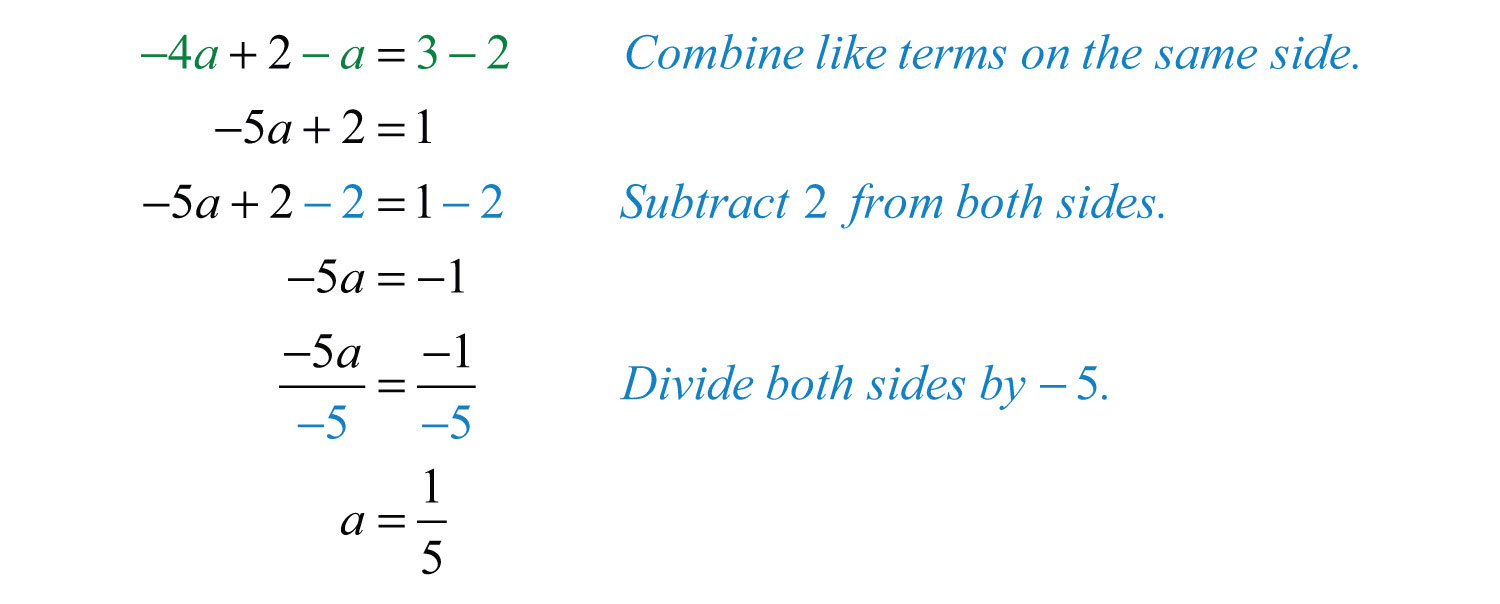
Answer: The solution is .
Opposite-Side Like Terms
Given a linear equation in the form , we begin by combining like terms on opposite sides of the equal sign. To combine opposite-side like termsLike terms of an equation on opposite sides of the equal sign., use the addition or subtraction property of equality to effectively “move terms” from one side to the other so that they can be combined.
Example 2: Solve: .
Solution: To “move” the term to the left side, subtract it on both sides.

From here, solve using the techniques developed previously.

Always check to see that the solution is correct by substituting the solution back into the original equation and simplifying to see if you obtain a true statement.

Answer: The solution is −2.
General Guidelines for Solving Linear Equations
When solving linear equations, the goal is to determine what value, if any, will produce a true statement when substituted in the original equation. Do this by isolating the variable using the following steps:
Step 1: Simplify both sides of the equation using the order of operations and combine all same-side like terms.
Step 2: Use the appropriate properties of equality to combine opposite-side like terms with the variable term on one side of the equation and the constant term on the other.
Step 3: Divide or multiply as needed to isolate the variable.
Step 4: Check to see if the answer solves the original equation.
Example 3: Solve: .
Solution: Simplify the linear expression on the left side before solving.
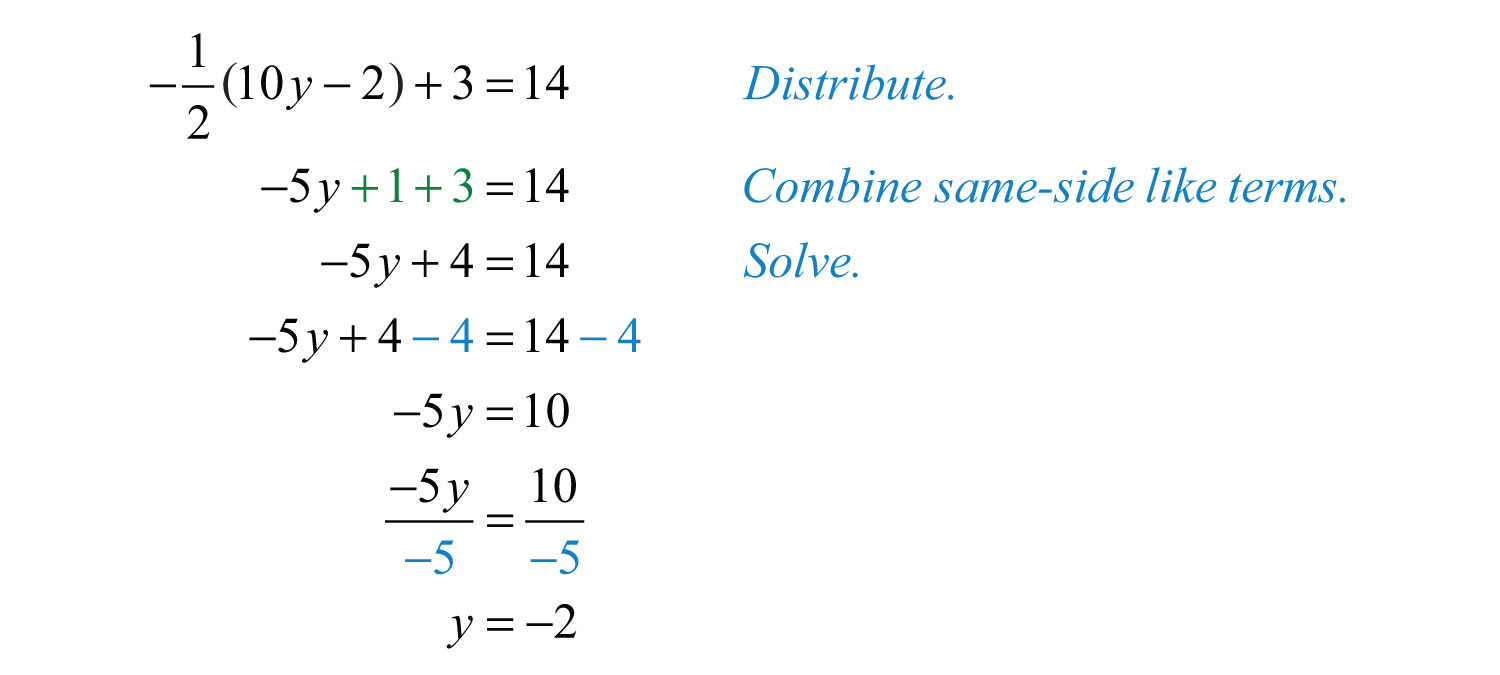
To check,
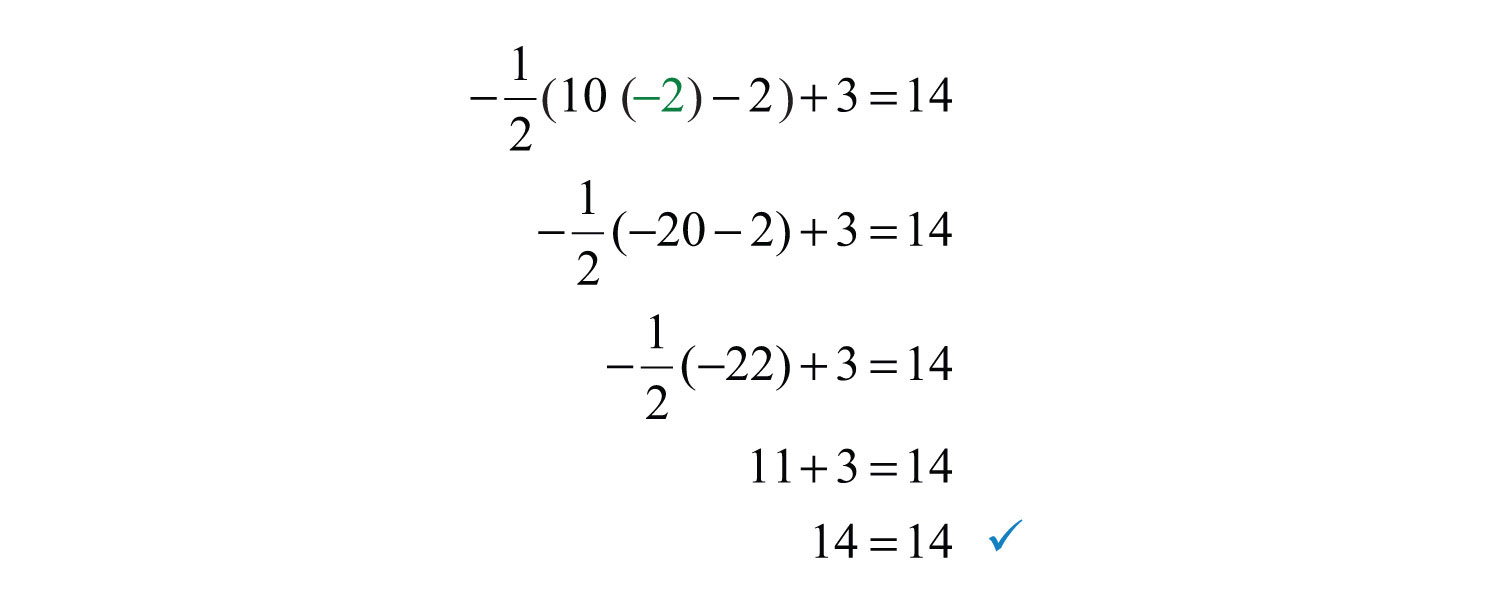
Answer: The solution is −2.
Example 4: Solve: .
Solution: First, simplify the expressions on both sides of the equal sign.
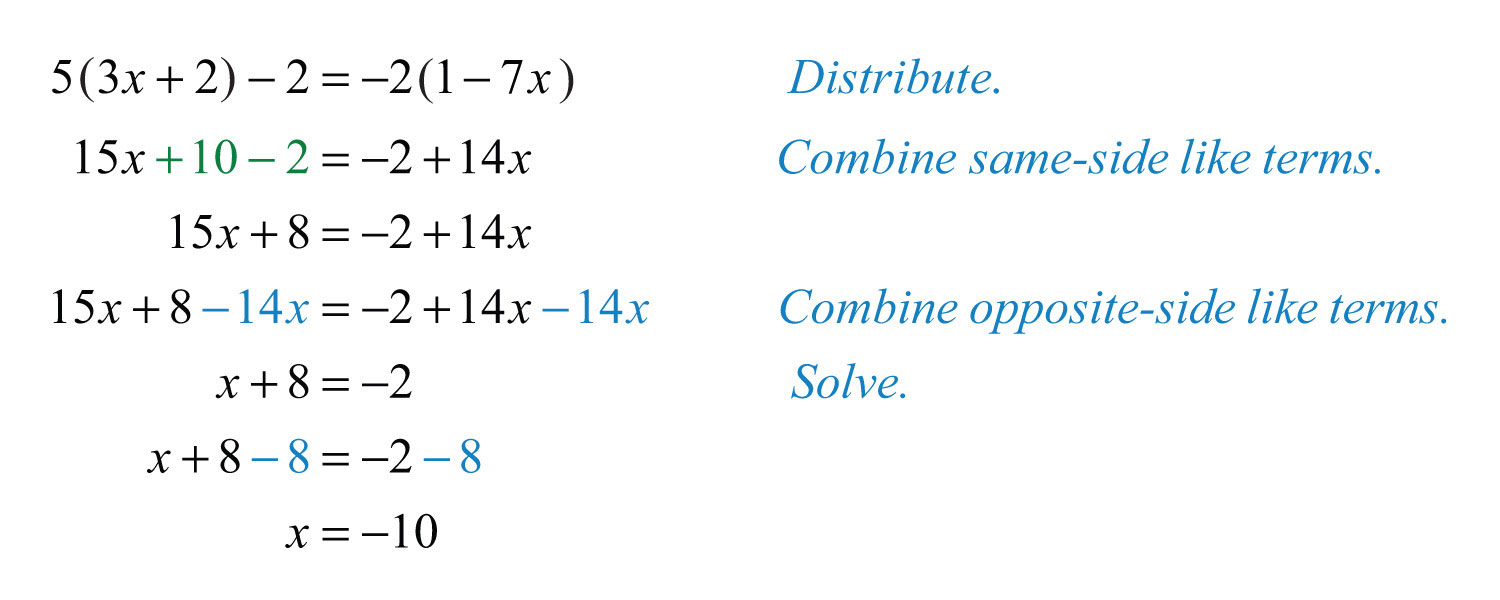
Answer: The solution is −10. The check is left as an exercise.
Try this! Solve: .
Answer:
Video Solution
(click to see video)Conditional Equations, Identities, and Contradictions
There are three different types of equations. Up to this point, we have been solving conditional equationsEquations that are true for particular values.. These are equations that are true for particular values. An identityAn equation that is true for all possible values. is an equation that is true for all possible values of the variable. For example,

has a solution set consisting of all real numbers, R. A contradictionAn equation that is never true and has no solution. is an equation that is never true and thus has no solutions. For example,

has no solution. We use the empty set, , to indicate that there are no solutions.
If the end result of solving an equation is a true statement, like 0 = 0, then the equation is an identity and any real number is a solution. If solving results in a false statement, like 0 = 1, then the equation is a contradiction and there is no solution.
Example 5: Solve: .
Solution:

Answer: . Solving leads to a false statement; therefore, the equation is a contradiction and there is no solution.
Example 6: Solve: .
Solution:

Answer: R. Solving leads to a true statement; therefore, the equation is an identity and any real number is a solution.
If it is hard to believe that any real number is a solution to the equation in the previous example, then choose your favorite real number, and substitute it in the equation to see that it leads to a true statement. Choose and check:

Try this! Solve: .
Answer: R
Video Solution
(click to see video)Clearing Decimals and Fractions
The coefficients of linear equations may be any real number, even decimals and fractions. When decimals and fractions are used, it is possible to use the multiplication property of equality to clear the coefficients in a single step. If given decimal coefficients, then multiply by an appropriate power of 10 to clear the decimals. If given fractional coefficients, then multiply both sides of the equation by the least common multiple of the denominators (LCD).
Example 7: Solve: .
Solution: Notice that all decimal coefficients are expressed with digits in the tenths place; this suggests that we can clear the decimals by multiplying both sides by 10. Take care to distribute 10 to each term on both sides of the equation.
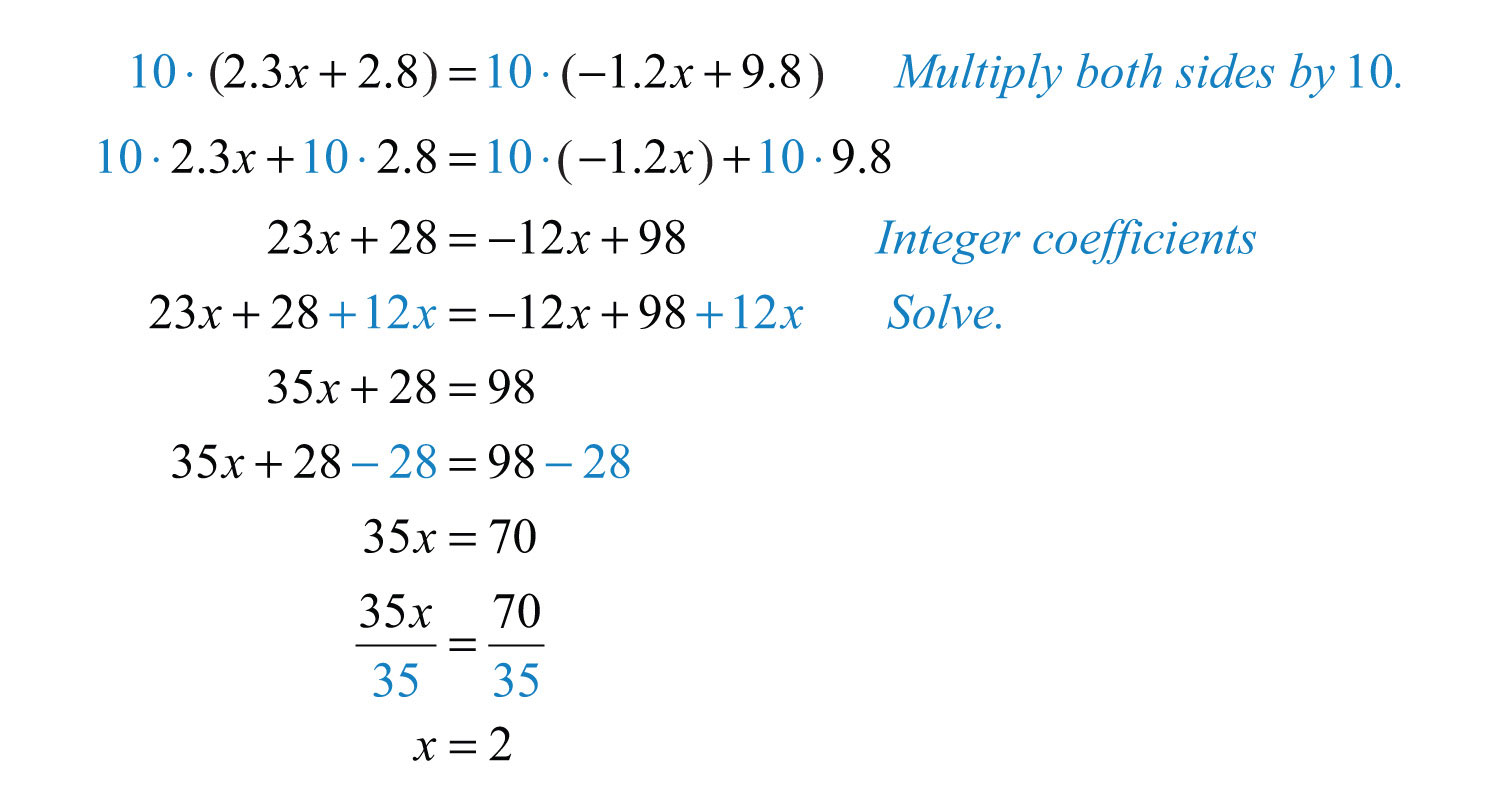
Answer: The solution is 2.
Example 8: Solve: .
Solution: Clear the fractions by multiplying both sides by the least common multiple of the given denominators. In this case, the .
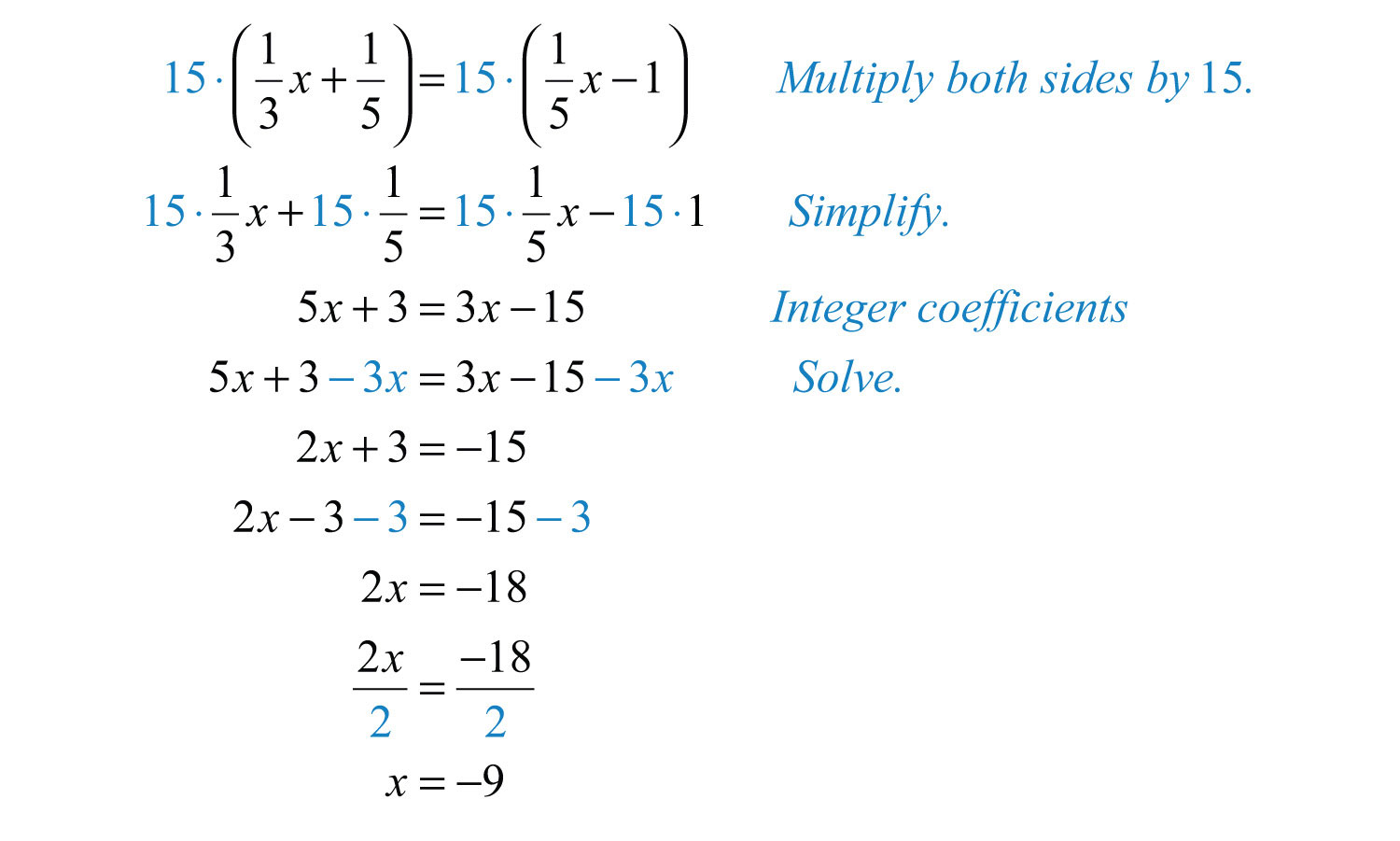
Answer: The solution is −9.
It is important to know that these techniques only work for equations. Do not try to clear fractions when simplifying expressions. As a reminder,

Solve equations and simplify expressions. If you multiply an expression by 6, you will change the problem. However, if you multiply both sides of an equation by 6, you obtain an equivalent equation.

Literal Equations (Linear Formulas)
Algebra lets us solve whole classes of applications using literal equationsA formula that summarizes whole classes of problems., or formulas. Formulas often have more than one variable and describe, or model, a particular real-world problem. For example, the familiar formula describes the distance traveled in terms of the average rate and time; given any two of these quantities, we can determine the third. Using algebra, we can solve the equation for any one of the variables and derive two more formulas.

If we divide both sides by r, we obtain the formula . Use this formula to find the time, given the distance and the rate.

If we divide both sides by t, we obtain the formula . Use this formula to find the rate, given the distance traveled and the time it takes to travel that distance. Using the techniques learned up to this point, we now have three equivalent formulas relating distance, average rate, and time:

When given a literal equation, it is often necessary to solve for one of the variables in terms of the others. Use the properties of equality to isolate the indicated variable.
Example 9: Solve for a: .
Solution: The goal is to isolate the variable a.

Answer:
Example 10: Solve for y: .
Solution: The goal is to isolate the variable y.

Answer:
Try this! Solve for b: .
Answer:
Video Solution
(click to see video)Key Takeaways
- Solving general linear equations involves isolating the variable, with coefficient 1, on one side of the equal sign.
-
The steps for solving linear equations are:
- Simplify both sides of the equation and combine all same-side like terms.
- Combine opposite-side like terms to obtain the variable term on one side of the equal sign and the constant term on the other.
- Divide or multiply as needed to isolate the variable.
- Check the answer.
- Most linear equations that you will encounter are conditional and have one solution.
- If solving a linear equation leads to a true statement like 0 = 0, then the equation is an identity and the solution set consists of all real numbers, R.
- If solving a linear equation leads to a false statement like 0 = 5, then the equation is a contradiction and there is no solution, .
- Clear fractions by multiplying both sides of a linear equation by the least common multiple of all the denominators. Distribute and multiply all terms by the LCD to obtain an equivalent equation with integer coefficients.
- Given a formula, solve for any variable using the same techniques for solving linear equations. This works because variables are simply representations of real numbers.
Topic Exercises
Part A: Checking for Solutions
Is the given value a solution to the linear equation?
1.
2.
3.
4.
5.
6.
Part B: Solving Linear Equations
Solve.
7.
8.
9.
10.
11.
12.
13.
14.
15.
16.
17.
18.
19.
20.
21.
22.
23.
24.
25.
26.
27.
28.
29.
30.
31.
32.
33.
34.
35.
36.
37.
38.
39.
40.
Part C: Solving Linear Equations Involving Parentheses
Solve.
41.
42.
43.
44.
45.
46.
47.
48.
49.
50.
51.
52.
53.
54.
55.
56.
57.
58.
59.
60.
61.
62.
63.
64.
65.
66.
67.
68.
69.
70.
Part D: Literal Equations
Solve for the indicated variable.
71. Solve for w: .
72. Solve for a: .
73. Solve for w: .
74. Solve for r: .
75. Solve for b: .
76. Solve for C: .
77. Solve for h: .
78. Solve for t: .
79. Solve for y: .
80. Solve for h: .
81. Solve for x: .
82. Solve for c: .
83. Solve for b: .
84. Solve for m: .
85. Solve for y: .
86. Solve for y: .
87. Solve for y: .
88. Solve for y: .
Translate the following sentences into linear equations and then solve.
89. The sum of 3x and 5 is equal to the sum of 2x and 7.
90. The sum of −5x and 6 is equal to the difference of 4x and 2.
91. The difference of 5x and 25 is equal to the difference of 3x and 51.
92. The sum of and is equal to .
93. A number n divided by 5 is equal to the sum of twice the number and 3.
94. Negative ten times a number n is equal to the sum of three times the number and 13.
Part E: Discussion Board Topics
95. What is the origin of the word algebra?
96. What is regarded as the main business of algebra?
97. Why is solving equations such an important algebra topic?
98. Post some real-world linear formulas not presented in this section.
99. Research and discuss the contributions of Diophantus of Alexandria.
100. Create an identity or contradiction of your own and share on the discussion board. Provide a solution and explain how you found it.
Answers
1: Yes
3: No
5: Yes
7: −4
9: −12
11: 2
13: 0
15: −3
17: 3.1
19: −26/15
21: 1/3
23: 25
25: −5/2
27: 7/3
29: −1
31:
33: 1/2
35: −3
37: R
39: −3/5
41: 1/2
43: 8
45: 4/3
47:
49: −3/2
51: 5
53: −14
55: 2
57: 0
59: −10/9
61: 3
63: 1
65: 17/11
67:
69: 7/6
71:
73:
75:
77:
79:
81:
83:
85:
87:
89: ;
91: ;
93: ;
2.5 Applications of Linear Equations
Learning Objectives
- Identify key words and phrases, translate sentences to mathematical equations, and develop strategies to solve problems.
- Solve word problems involving relationships between numbers.
- Solve geometry problems involving perimeter.
- Solve percent and money problems including simple interest.
- Set up and solve uniform motion problems.
Key Words, Translation, and Strategy
Algebra simplifies the process of solving real-world problems. This is done by using letters to represent unknowns, restating problems in the form of equations, and offering systematic techniques for solving those equations. To solve problems using algebra, first translate the wording of the problem into mathematical statements that describe the relationships between the given information and the unknowns. Usually, this translation to mathematical statements is the difficult step in the process. The key to the translation is to carefully read the problem and identify certain key words and phrases.
| Key Words | Translation |
|---|---|
| Sum, increased by, more than, plus, added to, total | + |
| Difference, decreased by, subtracted from, less, minus | − |
| Product, multiplied by, of, times, twice | * |
| Quotient, divided by, ratio, per | / |
| Is, total, result | = |
Here are some examples of translated key phrases.
| Key Phrases | Translation |
|---|---|
| The sum of a number and 7. | |
| Seven more than a number. | |
| The difference of a number and 7. | |
| Seven less than a number. | |
| Seven subtracted from a number. | |
| The product of 2 and a number. | |
| Twice a number. | |
| One-half of a number. | |
| The quotient of a number and 7. |
When translating sentences into mathematical statements, be sure to read the sentence several times and identify the key words and phrases.
Example 1: Translate: Four less than twice some number is 16.
Solution: First, choose a variable for the unknown number and identify the key words and phrases.
Let x represent the unknown indicated by “some number.”

Remember that subtraction is not commutative. For this reason, take care when setting up differences. In this example, is an incorrect translation.
Answer:
It is important to first identify the variable—let x represent…—and state in words what the unknown quantity is. This step not only makes your work more readable but also forces you to think about what you are looking for. Usually, if you know what you are asked to find, then the task of finding it is achievable.
Example 2: Translate: When 7 is subtracted from 3 times the sum of a number and 12, the result is 20.
Solution: Let n represent the unknown number.

Answer:
To understand why parentheses are needed, study the structures of the following two sentences and their translations:
| “3 times the sum of a number and 12” | |
| “the sum of 3 times a number and 12” |
The key is to focus on the phrase “3 times the sum.” This prompts us to group the sum within parentheses and then multiply by 3. Once an application is translated into an algebraic equation, solve it using the techniques you have learned.
Guidelines for Setting Up and Solving Word Problems
Step 1: Read the problem several times, identify the key words and phrases, and organize the given information.
Step 2: Identify the variables by assigning a letter or expression to the unknown quantities.
Step 3: Translate and set up an algebraic equation that models the problem.
Step 4: Solve the resulting algebraic equation.
Step 5: Finally, answer the question in sentence form and make sure it makes sense (check it).
For now, set up all of your equations using only one variable. Avoid two variables by looking for a relationship between the unknowns.
Problems Involving Relationships between Real Numbers
We classify applications involving relationships between real numbers broadly as number problems. These problems can sometimes be solved using some creative arithmetic, guessing, and checking. Solving in this manner is not a good practice and should be avoided. Begin by working through the basic steps outlined in the general guidelines for solving word problems.
Example 3: A larger integer is 2 less than 3 times a smaller integer. The sum of the two integers is 18. Find the integers.
Solution:
Identify variables: Begin by assigning a variable to the smaller integer.

Use the first sentence to identify the larger integer in terms of the variable x: “A larger integer is 2 less than 3 times a smaller.”

Set up an equation: Add the expressions that represent the two integers, and set the resulting expression equal to 18 as indicated in the second sentence: “The sum of the two integers is 18.”

Solve: Solve the equation to obtain the smaller integer x.
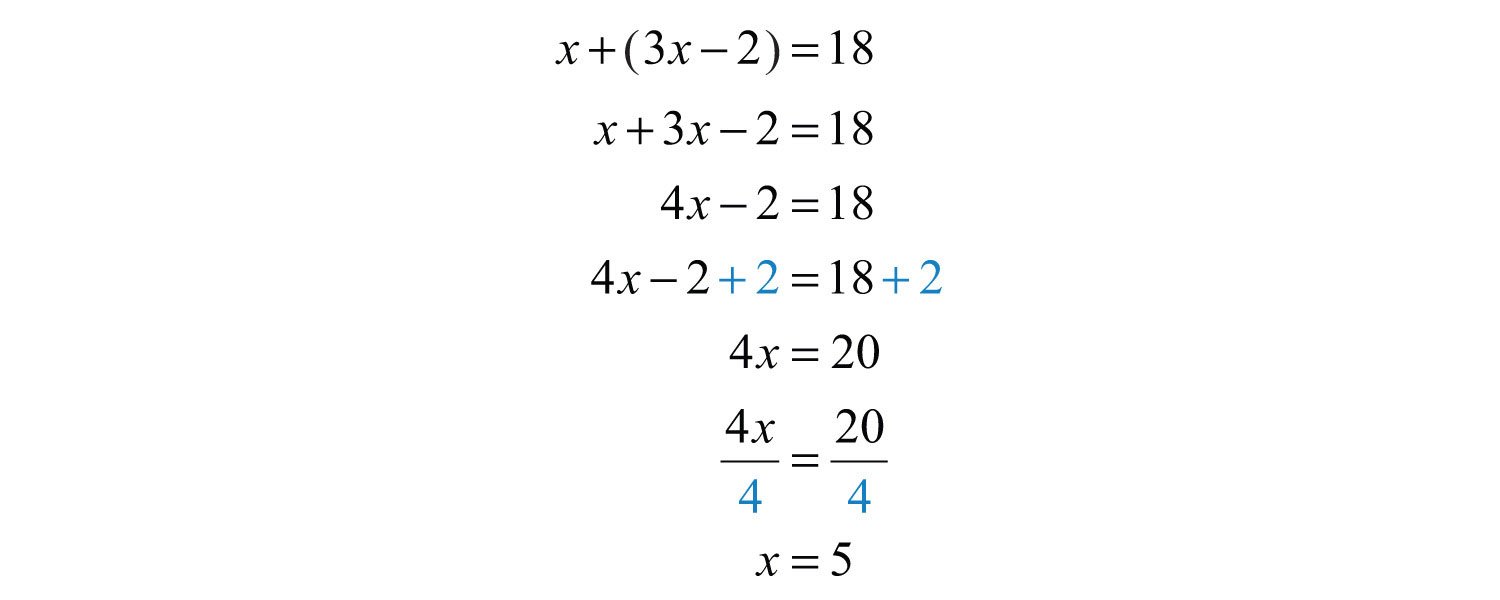
Back substitute: Use the expression to find the larger integer—this is called back substitutingThe process of finding the answers to other unknowns after one has been found..

Answer the question: The two integers are 5 and 13.
Check: 5 + 13 = 18. The answer makes sense.
Example 4: The difference between two integers is 2. The larger integer is 6 less than twice the smaller. Find the integers.
Solution: Use the relationship between the two integers in the second sentence, “The larger integer is 6 less than twice the smaller,” to identify the unknowns in terms of one variable.

Since the difference is positive, subtract the smaller integer from the larger.

Solve.

Use 2x − 6 to find the larger integer.

Answer: The two integers are 8 and 10. These integers clearly solve the problem.
It is worth mentioning again that you can often find solutions to simple problems by guessing and checking. This is so because the numbers are chosen to simplify the process of solving, so that the algebraic steps are not too tedious. You learn how to set up algebraic equations with easier problems, so that you can use these ideas to solve more difficult problems later.
Example 5: The sum of two consecutive even integers is 46. Find the integers.
Solution: The key phrase to focus on is “consecutive even integers.”

Add the even integers and set them equal to 46.

Solve.

Use x + 2 to find the next even integer.

Answer: The consecutive even integers are 22 and 24.
It should be clear that consecutive even integers are separated by two units. However, it may not be so clear that odd integers are as well.

Example 6: The sum of two consecutive odd integers is 36. Find the integers.
Solution: The key phrase to focus on is “consecutive odd integers.”

Add the two odd integers and set the expression equal to 36.

Solve.

Use x + 2 to find the next odd integer.

Answer: The consecutive odd integers are 17 and 19.
The algebraic setup for even and odd integer problems is the same. A common mistake is to use x and x + 3 when identifying the variables for consecutive odd integers. This is incorrect because adding 3 to an odd number yields an even number: for example, 5 + 3 = 8. An incorrect setup is very likely to lead to a decimal answer, which may be an indication that the problem was set up incorrectly.
Example 7: The sum of three consecutive integers is 24. Find the integers.
Solution: Consecutive integers are separated by one unit.

Add the integers and set the sum equal to 24.

Solve.

Back substitute to find the other two integers.

Answer: The three consecutive integers are 7, 8 and 9, where 7 + 8 + 9 = 24.
Try this! The sum of three consecutive odd integers is 87. Find the integers.
Answer: The integers are 27, 29, and 31.
Video Solution
(click to see video)Geometry Problems (Perimeter)
Recall that the perimeterThe sum of the lengths of all the outside edges of a polygon. of a polygon is the sum of the lengths of all the outside edges. In addition, it is helpful to review the following perimeter formulas ().
Perimeter of a rectangle, where l represents the length and w represents the width.: |
|
Perimeter of a square, where s represents the length of a side.: |
|
Perimeter of a triangle, where a, b, and c each represents the length of a different side.: |
|
Perimeter of a circle (circumferenceThe perimeter of a circle given by , where r represents the radius of the circle and .): |
Keep in mind that you are looking for a relationship between the unknowns so that you can set up algebraic equations using only one variable. When working with geometry problems, it is often helpful to draw a picture.
Example 8: A rectangle has a perimeter measuring 64 feet. The length is 4 feet more than 3 times the width. Find the dimensions of the rectangle.
Solution: The sentence “The length is 4 feet more than 3 times the width” gives the relationship between the two variables.


The sentence “A rectangle has a perimeter measuring 64 feet” suggests an algebraic setup. Substitute 64 for the perimeter and the expression for the length into the appropriate formula as follows:

Once you have set up an algebraic equation with one variable, solve for the width, w.

Use 3w + 4 to find the length.

Answer: The rectangle measures 7 feet by 25 feet. To check, add all of the sides:

Example 9: Two sides of a triangle are 5 and 7 inches longer than the third side. If the perimeter measures 21 inches, find the length of each side.

Solution: The first sentence describes the relationships between the unknowns.

Substitute these expressions into the appropriate formula and use 21 for the perimeter P.

You now have an equation with one variable to solve.
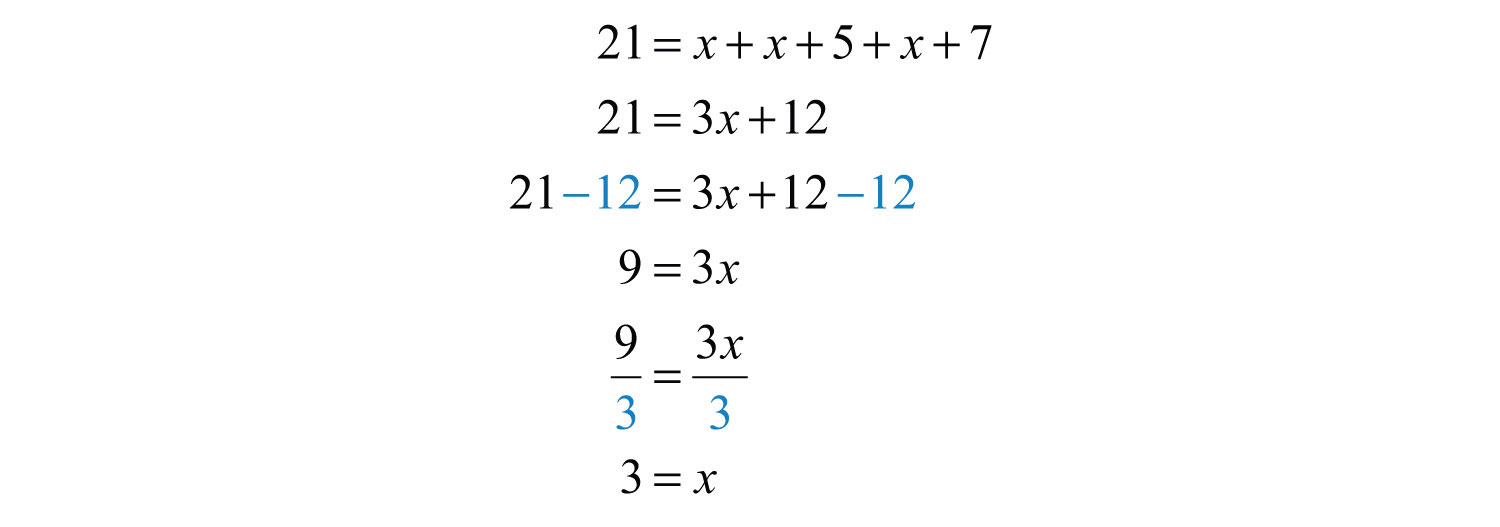
Back substitute.

Answer: The three sides of the triangle measure 3 inches, 8 inches, and 10 inches. The check is left to the reader.
Try this! The length of a rectangle is 1 foot less than twice its width. If the perimeter is 46 feet, find the dimensions.
Answer: Width: 8 feet; length: 15 feet
Video Solution
(click to see video)Problems Involving Money and Percents
Whenever setting up an equation involving a percentage, we usually need to convert the percentage to a decimal or fraction. If the question asks for a percentage, then do not forget to convert your answer to a percent at the end. Also, when money is involved, be sure to round off to two decimal places.
Example 10: If a pair of shoes costs $52.50 including a tax, what is the original cost of the item before taxes are added?
Solution: Begin by converting to a decimal.

The amount of tax is this rate times the original cost of the item. The original cost of the item is what you are asked to find.

Use this equation to solve for c, the original cost of the item.

Answer: The cost of the item before taxes is $48.95. Check this by multiplying $48.95 by 0.0725 to obtain the tax and add it to this cost.
Example 11: Given a annual interest rate, how long will it take $1,200 to yield $307.50 in simple interest?
Solution:

Organize the data needed to use the simple interest formula .
| Given interest for the time period: | |
| Given principal: | |
| Given rate: |
Next, substitute all of the known quantities into the formula and then solve for the only unknown, t.

Answer: It takes 5 years for $1,200 invested at to earn $307.50 in simple interest.
Example 12: Mary invested her total savings of $3,400 in two accounts. Her mutual fund account earned 8% last year and her CD earned 5%. If her total interest for the year was $245, how much was in each account?
Solution: The relationship between the two unknowns is that they total $3,400. When a total is involved, a common technique used to avoid two variables is to represent the second unknown as the difference of the total and the first unknown.

The total interest is the sum of the interest earned from each account.
| Interest earned in the mutual fund: | |
| Interest earned in the CD: |

This equation models the problem with one variable. Solve for x.

Back substitute.

Answer: Mary invested $2,500 at 8% in a mutual fund and $900 at 5% in a CD.
Example 13: Joe has a handful of dimes and quarters that values $5.30. He has one fewer than twice as many dimes than quarters. How many of each coin does he have?
Solution: Begin by identifying the variables.

To determine the total value of a number of coins, multiply the number of coins by the value of each coin. For example, 5 quarters have a value $0.25 ⋅ 5 = $1.25.

Solve for the number of quarters, q.
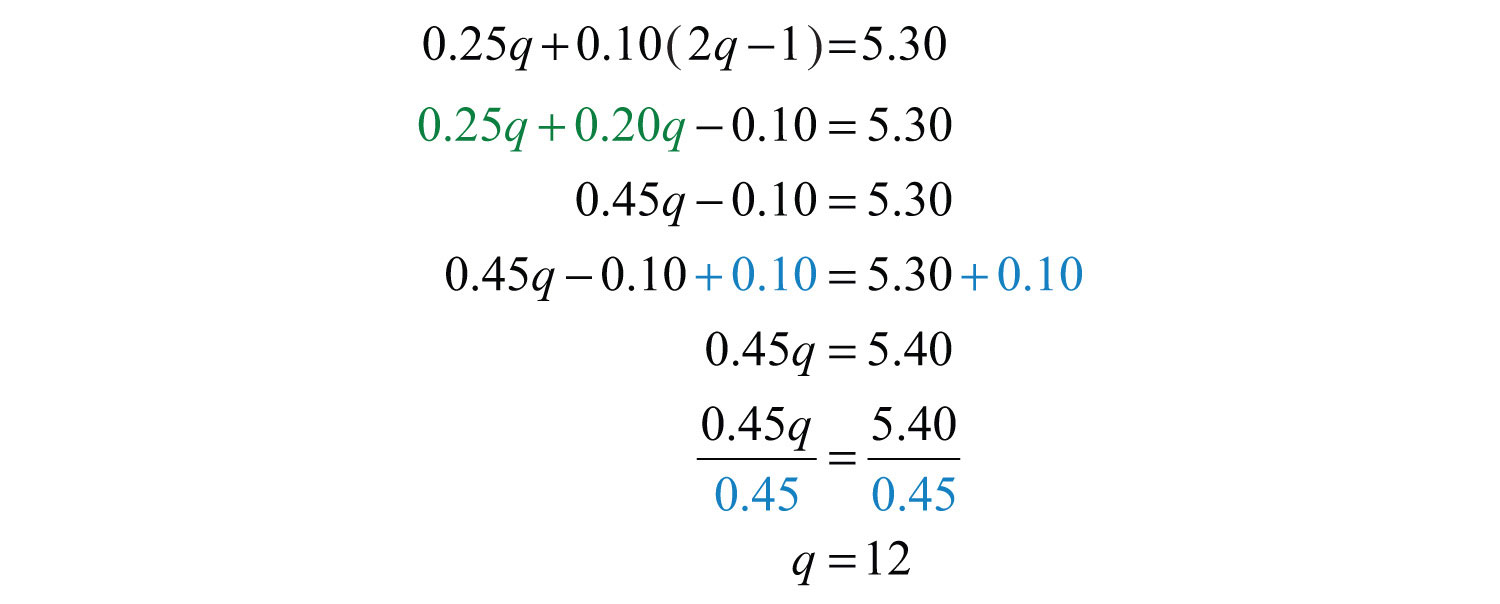
Back substitute into 2q − 1 to find the number of dimes.

Answer: Joe has 12 quarters and 23 dimes. Check by multiplying $0.25 ⋅ 12 = $3.00 and $0.10 ⋅ 23 = $2.30. Then add to obtain the correct amount: $3.00 + $2.30 = $5.30.
Try this! A total amount of $5,900 is invested in two accounts. One account earns 3.5% interest and another earns 4.5%. If the interest for 1 year is $229.50, then how much is invested in each account?
Answer: $3,600 is invested at 3.5% and $2,300 at 4.5%.
Video Solution
(click to see video)Uniform Motion Problems (Distance Problems)
Uniform motion refers to movement at a speed, or rate, that does not change. We can determine the distance traveled by multiplying the average rate by the time traveled at that rate with the formula . Applications involving uniform motion usually have a lot of data, so it helps to first organize the data in a chart and then set up an algebraic equation that models the problem.
Example 14: Two trains leave the station at the same time traveling in opposite directions. One travels at 70 miles per hour and the other at 60 miles per hour. How long does it take for the distance between them to reach 390 miles?
Solution: First, identify the unknown quantity and organize the data.


The given information is filled in on the following chart. The time for each train is equal.

To avoid introducing two more variables, use the formula to fill in the unknown distances traveled by each train.

We can now completely fill in the chart.

The algebraic setup is defined by the distance column. The problem asks for the time it takes for the total distance to reach 390 miles.
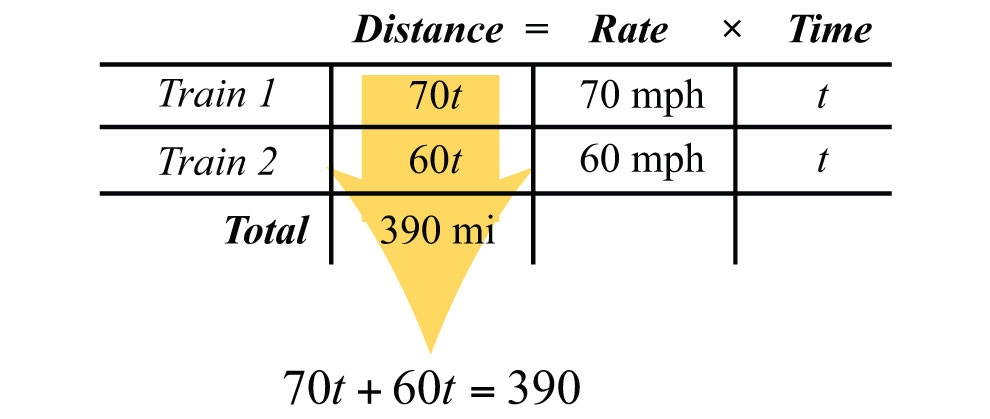
Solve for t.

Answer: It takes 3 hours for the distance between the trains to reach 390 miles.
Example 15: A train traveling nonstop to its destination is able to make the trip at an average speed of 72 miles per hour. On the return trip, the train makes several stops and is only able to average 48 miles per hour. If the return trip takes 2 hours longer than the initial trip to the destination, then what is the travel time each way?
Solution: First, identify the unknown quantity and organize the data.

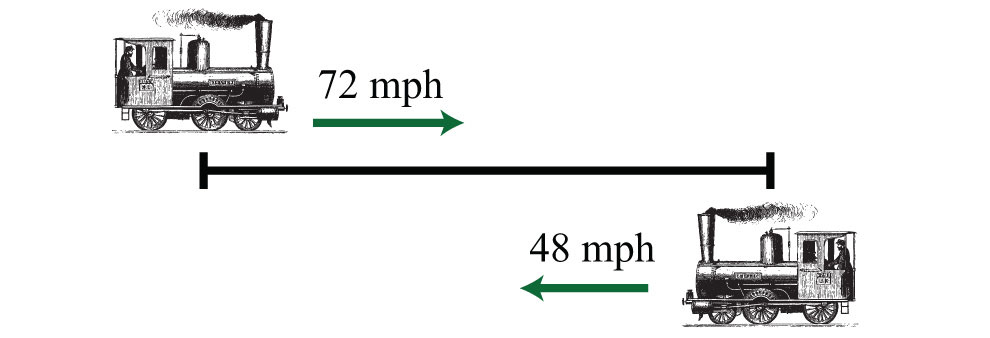
The given information is filled in the following chart:

Use the formula to fill in the unknown distances.

Use these expressions to complete the chart.

The algebraic setup is again defined by the distance column. In this case, the distance to the destination and back is the same, and the equation is

Solve for t.
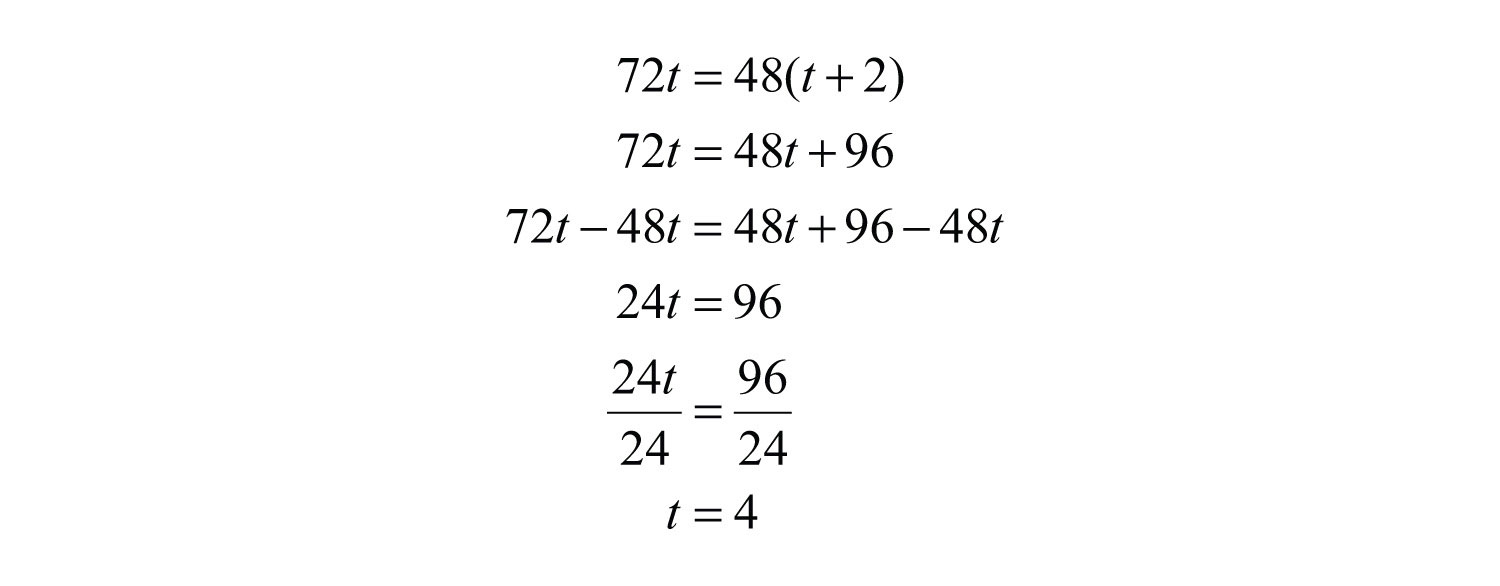
The return trip takes hours.
Answer: It takes 4 hours to arrive at the destination and 6 hours to return.
Try this! Mary departs for school on a bicycle at an average rate of 6 miles per hour. Her sister Kate, running late, leaves 15 minutes later and cycles at twice that speed. How long will it take Kate to catch up to Mary? Be careful! Pay attention to the units given in the problem.
Answer: It takes 15 minutes for Kate to catch up.
Video Solution
(click to see video)Key Takeaways
- Simplify the process of solving real-world problems by creating mathematical models that describe the relationship between unknowns. Use algebra to solve the resulting equations.
- Guessing and checking for solutions is a poor practice. This technique might sometimes produce correct answers, but is unreliable, especially when problems become more complex.
- Read the problem several times and search for the key words and phrases. Identify the unknowns and assign variables or expressions to the unknown quantities. Look for relationships that allow you to use only one variable. Set up a mathematical model for the situation and use algebra to solve the equation. Check to see if the solution makes sense and present the solution in sentence form.
- Do not avoid word problems: solving them can be fun and rewarding. With lots of practice you will find that they really are not so bad after all. Modeling and solving applications is one of the major reasons to study algebra.
- Do not feel discouraged when the first attempt to solve a word problem does not work. This is part of the process. Try something different and learn from incorrect attempts.
Topic Exercises
Part A: Translate
Translate the following into algebraic equations.
1. The sum of a number and 6 is 37.
2. When 12 is subtracted from twice some number the result is 6.
3. Fourteen less than 5 times a number is 1.
4. Twice some number is subtracted from 30 and the result is 50.
5. Five times the sum of 6 and some number is 20.
6. The sum of 5 times some number and 6 is 20.
7. When the sum of a number and 3 is subtracted from 10 the result is 5.
8. The sum of three times a number and five times that same number is 24.
9. Ten is subtracted from twice some number and the result is the sum of the number and 2.
10. Six less than some number is ten times the sum of that number and 5.
Part B: Number Problems
Set up an algebraic equation and then solve.
11. A larger integer is 1 more than twice another integer. If the sum of the integers is 25, find the integers.
12. If a larger integer is 2 more than 4 times another integer and their difference is 32, find the integers.
13. One integer is 30 more than another integer. If the difference between the larger and twice the smaller is 8, find the integers.
14. The quotient of some number and 4 is 22. Find the number.
15. Eight times a number is decreased by three times the same number, giving a difference of 20. What is the number?
16. One integer is two units less than another. If their sum is −22, find the two integers.
17. The sum of two consecutive integers is 139. Find the integers.
18. The sum of three consecutive integers is 63. Find the integers.
19. The sum of three consecutive integers is 279. Find the integers.
20. The difference of twice the smaller of two consecutive integers and the larger is 39. Find the integers.
21. If the smaller of two consecutive integers is subtracted from two times the larger, then the result is 17. Find the integers.
22. The sum of two consecutive even integers is 46. Find the integers.
23. The sum of two consecutive even integers is 238. Find the integers.
24. The sum of three consecutive even integers is 96. Find the integers.
25. If the smaller of two consecutive even integers is subtracted from 3 times the larger the result is 42. Find the integers.
26. The sum of three consecutive even integers is 90. Find the integers.
27. The sum of two consecutive odd integers is 68. Find the integers.
28. The sum of two consecutive odd integers is 180. Find the integers.
29. The sum of three consecutive odd integers is 57. Find the integers.
30. If the smaller of two consecutive odd integers is subtracted from twice the larger the result is 23. Find the integers.
31. Twice the sum of two consecutive odd integers is 32. Find the integers.
32. The difference between twice the larger of two consecutive odd integers and the smaller is 59. Find the integers.
Part C: Geometry Problems
Set up an algebraic equation and then solve.
33. If the perimeter of a square is 48 inches, then find the length of each side.
34. The length of a rectangle is 2 inches longer than its width. If the perimeter is 36 inches, find the length and width.
35. The length of a rectangle is 2 feet less than twice its width. If the perimeter is 26 feet, find the length and width.
36. The width of a rectangle is 2 centimeters less than one-half its length. If the perimeter is 56 centimeters, find the length and width.
37. The length of a rectangle is 3 feet less than twice its width. If the perimeter is 54 feet, find the dimensions of the rectangle.
38. If the length of a rectangle is twice as long as the width and its perimeter measures 72 inches, find the dimensions of the rectangle.
39. The perimeter of an equilateral triangle measures 63 centimeters. Find the length of each side.
40. An isosceles triangle whose base is one-half as long as the other two equal sides has a perimeter of 25 centimeters. Find the length of each side.
41. Each of the two equal legs of an isosceles triangle are twice the length of the base. If the perimeter is 105 centimeters, then how long is each leg?
42. A triangle has sides whose measures are consecutive even integers. If the perimeter is 42 inches, find the measure of each side.
43. A triangle has sides whose measures are consecutive odd integers. If the perimeter is 21 inches, find the measure of each side.
44. A triangle has sides whose measures are consecutive integers. If the perimeter is 102 inches, then find the measure of each side.
45. The circumference of a circle measures units. Find the radius.
46. The circumference of a circle measures units. Find the radius.
47. The circumference of a circle measures 100 centimeters. Determine the radius to the nearest tenth.
48. The circumference of a circle measures 20 centimeters. Find the diameter rounded off to the nearest hundredth.
49. The diameter of a circle measures 5 inches. Determine the circumference to the nearest tenth.
50. The diameter of a circle is 13 feet. Calculate the exact value of the circumference.
Part D: Percent and Money Problems
Set up an algebraic equation and then solve.
51. Calculate the simple interest earned on a 2-year investment of $1,550 at a 8¾% annual interest rate.
52. Calculate the simple interest earned on a 1-year investment of $500 at a 6% annual interest rate.
53. For how many years must $10,000 be invested at an 8½% annual interest rate to yield $4,250 in simple interest?
54. For how many years must $1,000 be invested at a 7.75% annual interest rate to yield $503.75 in simple interest?
55. At what annual interest rate must $2,500 be invested for 3 years in order to yield $412.50 in simple interest?
56. At what annual interest rate must $500 be invested for 2 years in order to yield $93.50 in simple interest?
57. If the simple interest earned for 1 year was $47.25 and the annual rate was 6.3%, what was the principal?
58. If the simple interest earned for 2 years was $369.60 and the annual rate was 5¼%, what was the principal?
59. Joe invested last year’s $2,500 tax return in two different accounts. He put most of the money in a money market account earning 5% simple interest. He invested the rest in a CD earning 8% simple interest. How much did he put in each account if the total interest for the year was $138.50?
60. James invested $1,600 in two accounts. One account earns 4.25% simple interest and the other earns 8.5%. If the interest after 1 year was $85, how much did he invest in each account?
61. Jane has her $5,400 savings invested in two accounts. She has part of it in a CD at 3% annual interest and the rest in a savings account that earns 2% annual interest. If the simple interest earned from both accounts is $140 for the year, then how much does she have in each account?
62. Marty put last year’s bonus of $2,400 into two accounts. He invested part in a CD with 2.5% annual interest and the rest in a money market fund with 1.3% annual interest. His total interest for the year was $42.00. How much did he invest in each account?
63. Alice puts money into two accounts, one with 2% annual interest and another with 3% annual interest. She invests 3 times as much in the higher yielding account as she does in the lower yielding account. If her total interest for the year is $27.50, how much did she invest in each account?
64. Jim invested an inheritance in two separate banks. One bank offered 5.5% annual interest rate and the other 6¼%. He invested twice as much in the higher yielding bank account than he did in the other. If his total simple interest for 1 year was $4,860, then what was the amount of his inheritance?
65. If an item is advertised to cost $29.99 plus 9.25% tax, what is the total cost?
66. If an item is advertised to cost $32.98 plus 8¾% tax, what is the total cost?
67. An item, including an 8.75% tax, cost $46.49. What is the original pretax cost of the item?
68. An item, including a 5.48% tax, cost $17.82. What is the original pretax cost of the item?
69. If a meal costs $32.75, what is the total after adding a 15% tip?
70. How much is a 15% tip on a restaurant bill that totals $33.33?
71. Ray has a handful of dimes and nickels valuing $3.05. He has 5 more dimes than he does nickels. How many of each coin does he have?
72. Jill has 3 fewer half-dollars than she has quarters. The value of all 27 of her coins adds to $9.75. How many of each coin does Jill have?
73. Cathy has to deposit $410 worth of five- and ten-dollar bills. She has 1 fewer than three times as many tens as she does five-dollar bills. How many of each bill does she have to deposit?
74. Billy has a pile of quarters, dimes, and nickels that values $3.75. He has 3 more dimes than quarters and 5 more nickels than quarters. How many of each coin does Billy have?
75. Mary has a jar with one-dollar bills, half-dollar coins, and quarters valuing $14.00. She has twice as many quarters than she does half-dollar coins and the same amount of half-dollar coins as one-dollar bills. How many of each does she have?
76. Chad has a bill-fold of one-, five-, and ten-dollar bills totaling $118. He has 2 more than 3 times as many ones as he does five-dollar bills and 1 fewer ten- than five-dollar bills. How many of each bill does Chad have?
Part D: Uniform Motion (Distance Problems)
Set up an algebraic equation then solve.
77. Two cars leave a location traveling in opposite directions. If one car averages 55 miles per hour and the other averages 65 miles per hour, then how long will it take for them to separate a distance of 300 miles?
78. Two planes leave the airport at the same time traveling in opposite directions. The average speeds for the planes are 450 miles per hour and 395 miles per hour. How long will it take the planes to be a distance of 1,478.75 miles apart?
79. Bill and Ted are racing across the country. Bill leaves 1 hour earlier than Ted and travels at an average rate of 60 miles per hour. If Ted intends to catch up at a rate of 70 miles per hour, then how long will it take?
80. Two brothers leave from the same location, one in a car and the other on a bicycle, to meet up at their grandmother’s house for dinner. If one brother averages 30 miles per hour in the car and the other averages 12 miles per hour on the bicycle, then it takes the brother on the bicycle 1 hour less than 3 times as long as the other in the car. How long does it take each of them to make the trip?
81. A commercial airline pilot flew at an average speed of 350 miles per hour before being informed that his destination airfield may be closed due to poor weather conditions. In an attempt to arrive before the storm, he increased his speed 400 miles per hour and flew for another 3 hours. If the total distance flown was 2,950 miles, then how long did the trip take?
82. Two brothers drove the 2,793 miles from Los Angeles to New York. One of the brothers, driving during the day, was able to average 70 miles per hour, and the other, driving at night, was able to average 53 miles per hour. If the brother driving at night drove 3 hours less than the brother driving in the day, then how many hours did they each drive?
83. Joe and Ellen live 21 miles apart. Departing at the same time, they cycle toward each other. If Joe averages 8 miles per hour and Ellen averages 6 miles per hour, how long will it take them to meet?
84. If it takes 6 minutes to drive to the automobile repair shop at an average speed of 30 miles per hour, then how long will it take to walk back at an average rate of 4 miles per hour?
85. Jaime and Alex leave the same location and travel in opposite directions. Traffic conditions enabled Alex to average 14 miles per hour faster than Jaime. After 1½ hours they are 159 miles apart. Find the speed at which each was able to travel.
86. Jane and Holly live 51 miles apart and leave at the same time traveling toward each other to meet for lunch. Jane traveled on the freeway at twice the average speed as Holly. They were able to meet in a half hour. At what rate did each travel?
Part F: Discussion Board Topics
87. Discuss ideas for calculating taxes and tips mentally.
88. Research historical methods for representing unknowns.
89. Research and compare simple interest and compound interest. What is the difference?
90. Discuss why algebra is a required subject.
91. Research ways to show that a repeating decimal is rational. Share your findings on the discussion board.
Answers
1:
3:
5:
7:
9:
11: 8, 17
13: 22, 52
15: 4
17: 69, 70
19: 92, 93, 94
21: 15, 16
23: 118, 120
25: 18, 20
27: 33, 35
29: 17, 19, 21
31: 7, 9
33: 12 inches
35: Width: 5 feet; length: 8 feet
37: Width: 10 feet; length: 17 feet
39: 21 centimeters
41: 21 centimeters, 42 centimeters, 42 centimeters
43: 5 inches, 7 inches, 9 inches
45: 25 units
47: 15.9 centimeters
49: 15.7 inches
51: $271.25
53: 5 years
55: 5.5%
57: $750.00
59: Joe invested $2,050 in the money market account and $450 in the CD.
61: Jane has $3,200 in the CD and $2,200 in savings.
63: Alice invested $250 at 2% and $750 at a 3%.
65: $32.76
67: $42.75
69: $37.66
71: He has 17 nickels and 22 dimes.
73: Cathy has 12 fives and 35 ten-dollar bills.
75: Mary has 7 one-dollar bills, 7 half-dollar coins, and 14 quarters.
77: 2.5 hours
79: 6 hours
81: 8 hours
83: 1½ hours
85: Jaime: 46 miles per hour; Alex: 60 miles per hour
2.6 Ratio and Proportion Applications
Learning Objectives
- Understand the difference between a ratio and a proportion.
- Solve proportions using cross multiplication.
- Solve applications involving proportions, including similar triangles.
Definitions
A ratioRelationship between two numbers or quantities usually expressed as a quotient. is a relationship between two numbers or quantities usually expressed as a quotient. Ratios are typically expressed using the following notation:

All of the above are equivalent forms used to express a ratio. However, the most familiar way to express a ratio is in the form of a fraction. When writing ratios, it is important to pay attention to the units. If the units are the same, then the ratio can be written without them.
Example 1: Express the ratio 12 feet to 48 feet in reduced form.
Solution:

Answer: 1 to 4
If the units are different, then we must be sure to include them because the ratio represents a rateA ratio where the units for the numerator and the denominator are different..
Example 2: Express the ratio 220 miles to 4 hours in reduced form.
Solution:

Answer: 55 miles to 1 hour (or 55 miles per hour)
Rates are useful when determining unit costThe price of each unit., or the price of each unit. We use the unit cost to compare values when the quantities are not the same. To determine the unit cost, divide the cost by the number of units.
Example 3: A local supermarket offers a pack of 12 sodas for $3.48 on sale, and the local discount warehouse offers the soda in a 36-can case for $11.52. Which is the better value?
Solution: Divide the cost by the number of cans to obtain the unit price.
| Supermarket | Discount warehouse |
|---|---|
Answer: The supermarket sale price of $3.48 for a 12-pack is a better value at $0.29 per can.
A proportionA statement of the equality of two ratios. is a statement of equality of two ratios.

This proportion is often read “a is to b as c is to d.” Here is an example of a simple proportion,

If we clear the fractions by multiplying both sides of the proportion by the product of the denominators, 8, then we obtain the following true statement:

Given any nonzero real numbers a, b, c, and d that satisfy a proportion, multiply both sides by the product of the denominators to obtain the following:

This shows that cross products are equal, and is commonly referred to as cross multiplicationIf , then ..

Solving Proportions
Cross multiply to solve proportions where terms are unknown.
Example 4: Solve: .
Solution: Cross multiply and then solve for n.
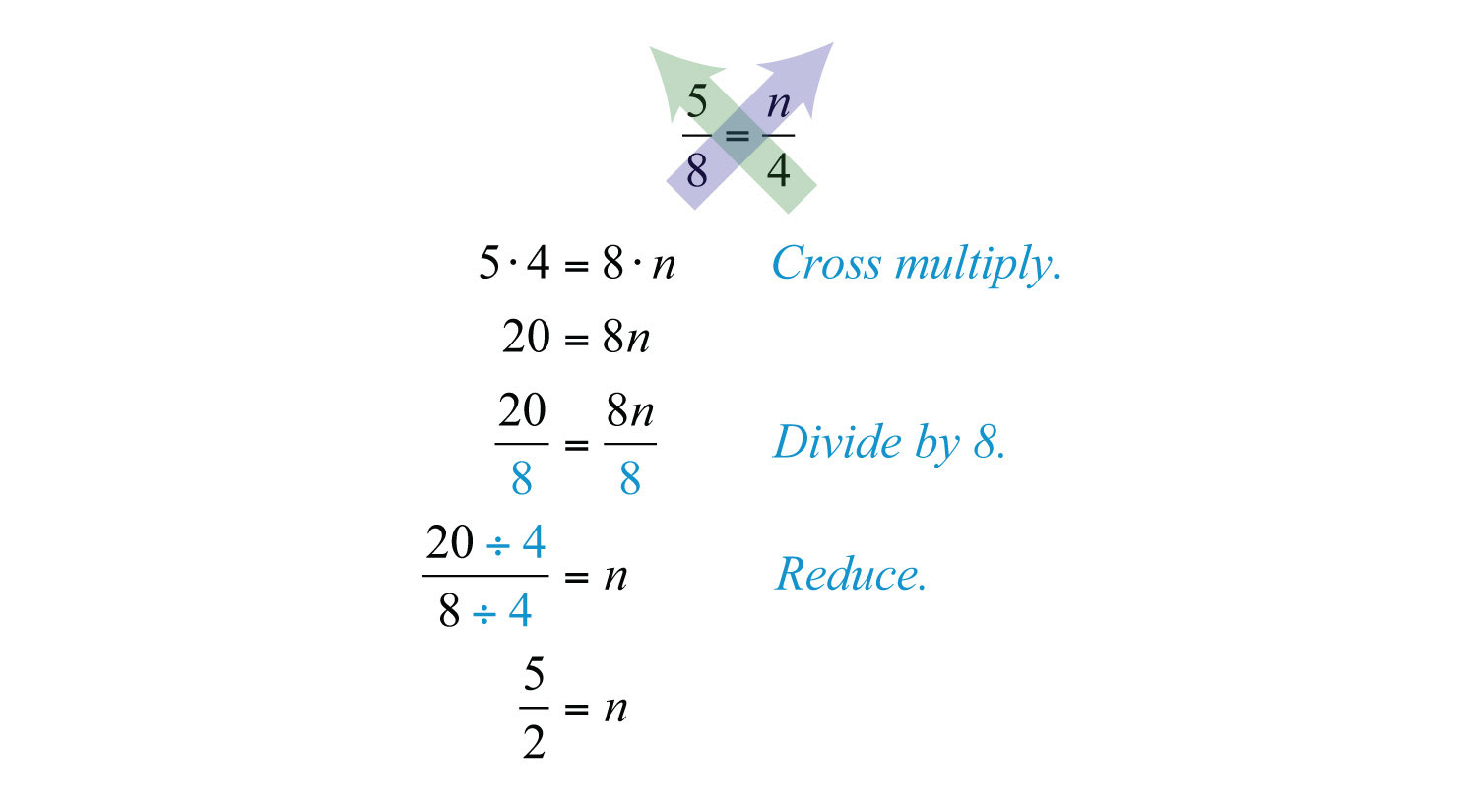
Answer:
Example 5: Solve: .
Solution: Cross multiply then solve for x.

Answer:
Example 6: Solve: .
Solution: When cross multiplying, be sure to group . Apply the distributive property in the next step.
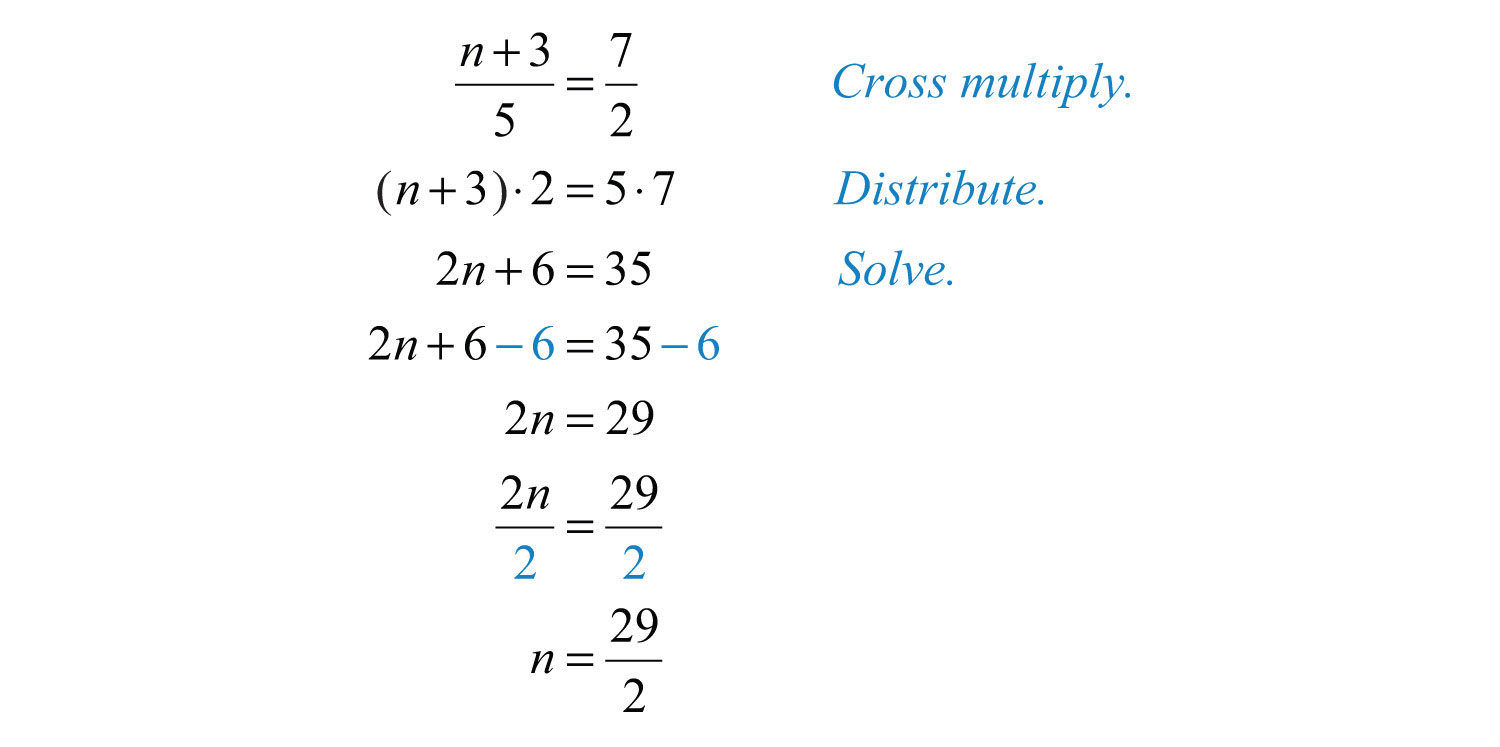
Answer:
Try this! Solve: .
Answer:
Video Solution
(click to see video)Applications
When setting up proportions, consistency with the units of each ratio is critical. Units for the numerators should be the same and units for the denominators should also be the same.
Example 7: It is claimed that 2 out of 3 dentists prefer a certain brand of toothpaste. If 600 dentists are surveyed, then how many will say they prefer that brand?
Solution: First, identify the unknown and assign it a variable.

Since you are looking for the number of dentists who prefer the brand name out of a total of 600 surveyed, construct the ratios with the number of dentists who prefer the brand in the numerator and the total number surveyed in the denominator.

Cross multiply and solve for n,

Answer: The claim suggests that 400 out of 600 dentists surveyed prefer the brand name.
Example 8: In Tulare County, 3 out of every 7 voters said yes to Proposition 40. If 42,000 people voted, how many said no to Proposition 40?
Solution: The problem gives the ratio of voters who said yes, but it asks for the number who said no.

If 3 out of 7 said yes, then we can assume 4 out of 7 said no. Set up the ratios with the number of voters who said no in the numerator and the total number of voters in the denominator.

Cross multiply and solve for n.

Answer: 24,000 voters out of 42,000 said no.
Example 9: The sum of two integers in the ratio of 4 to 5 is 27. Find the integers.
Solution: The sum of two integers is 27; use this relationship to avoid two variables.

The integers are given to be in the ratio of 4 to 5. Set up the following proportion:
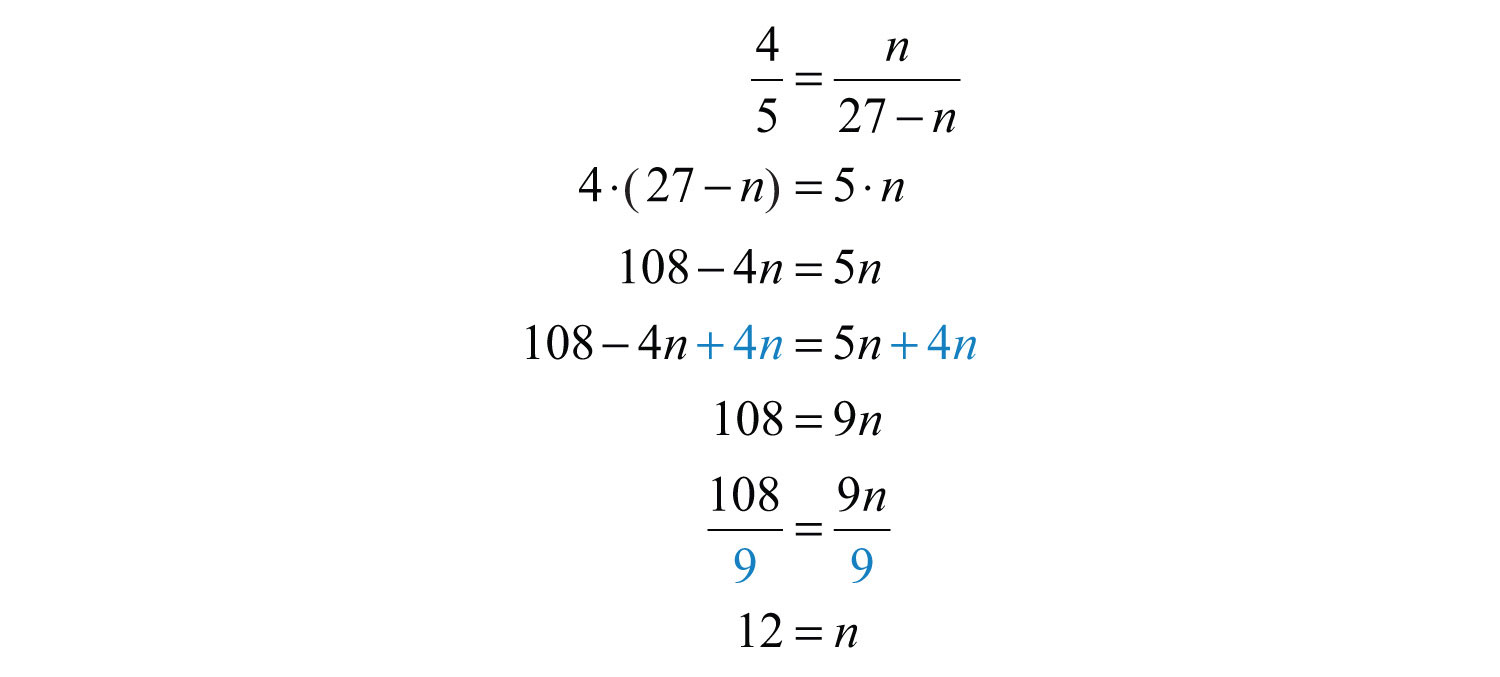
Use 27 − n to determine the other integer.

Answer: The integers are 12 and 15.
Try this! A recipe calls for 5 tablespoons of sugar for every 8 cups of flour. How many tablespoons of sugar are required for 32 cups of flour?
Answer: 20 tablespoons of sugar
Video Solution
(click to see video)Similar Triangles
We will often encounter proportion problems in geometry and trigonometry. One application involves similar trianglesTriangles with the same shape but not necessarily the same size. The measures of corresponding angles are equal and the corresponding sides are proportional., which have the same shape, but not necessarily the same size. The measures of the corresponding angles of similar triangles are equal, and the measures of the corresponding sides are proportional. Given similar triangles ABC and RST,

We may write and conclude that all of the corresponding angles are equal. The notation indicates that angle A corresponds to angle R and that the measures of these angles are equal: A = R.

In addition, the measures of other pairs of corresponding angles are equal: B = S and C = T.

Use uppercase letters for angles and a lowercase letter to denote the side opposite of the given angle. Denote the proportionality of the sides as follows:

Example 10: If triangle ABC is similar to RST, where , , , and , then find the remaining two sides.
Solution: Draw a picture and identify the variables pictorially. Represent the remaining unknown sides by s and t. Set up proportions and solve for the missing sides.
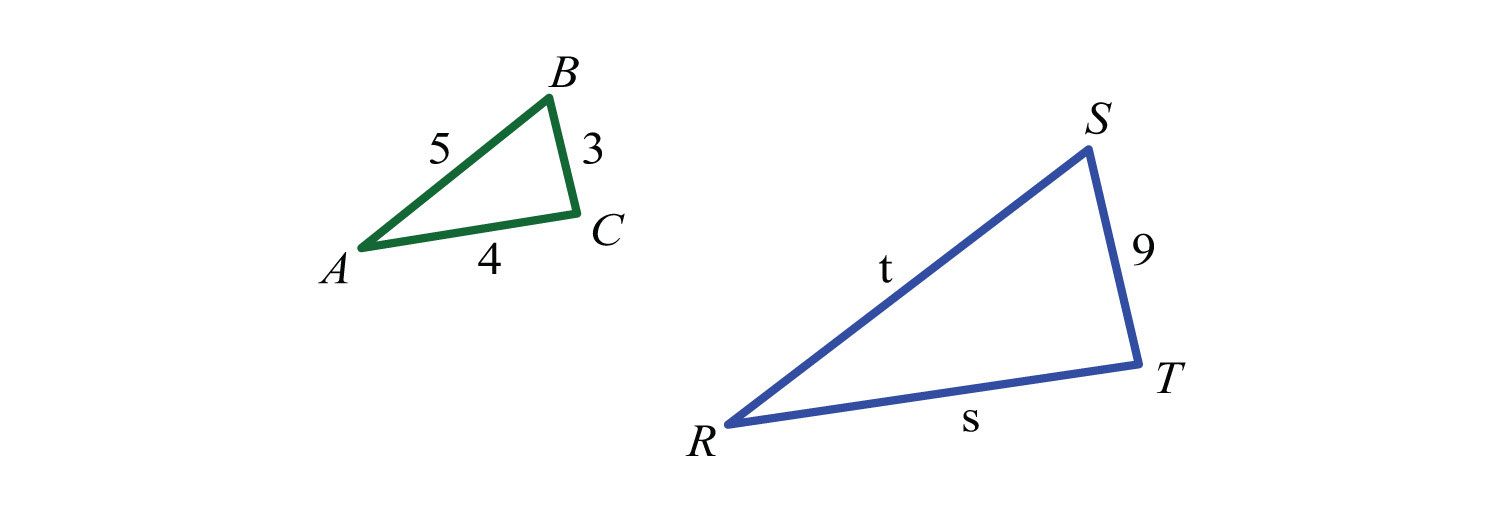
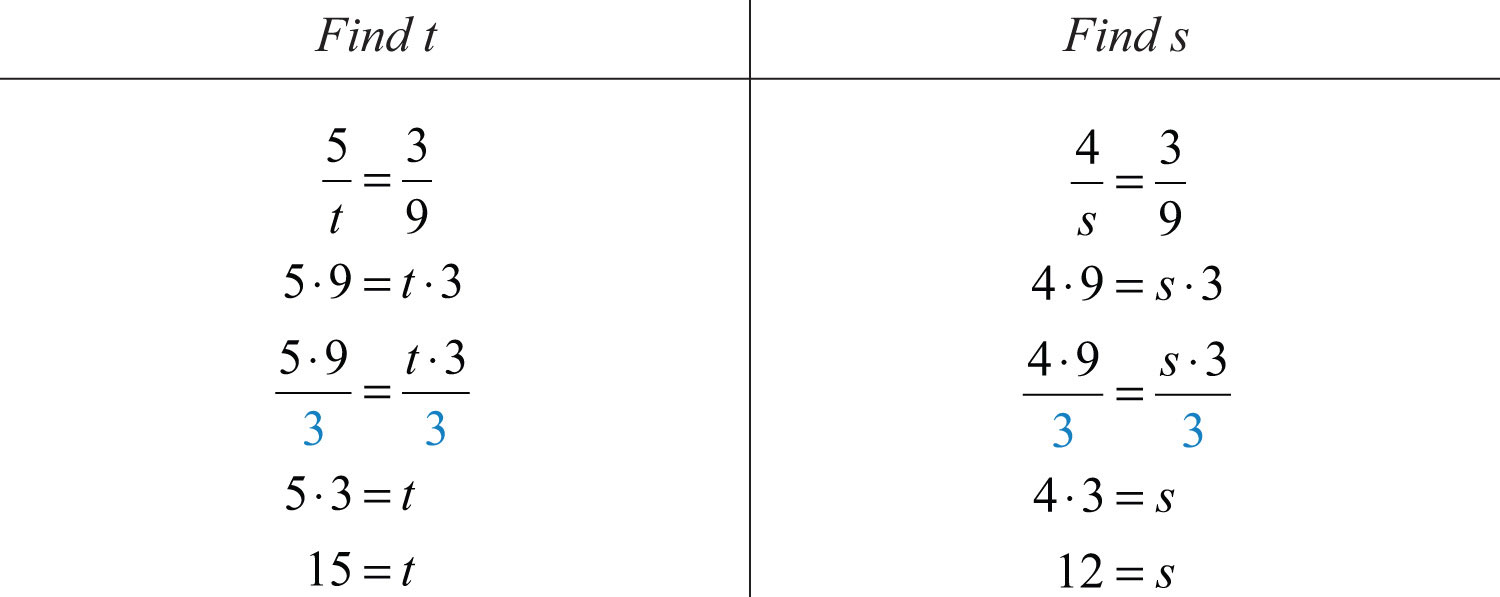
Answer: The two remaining sides measure 12 units and 15 units.
The reduced ratio of any two corresponding sides of similar triangles is called the scale factorThe reduced ratio of any two corresponding sides of similar triangles.. In the previous example, the ratio of the two given sides a and r is

Therefore, triangle ABC is similar to triangle RST with a scale factor of 1/3. This means that each leg of triangle ABC is 1/3 of the measure of the corresponding legs of triangle RST. Also, another interesting fact is that the perimeters of similar triangles are in the same proportion as their sides and share the same scale factor.
Example 11: If a triangle ABC has a perimeter of 12 units and is similar to RST with a scale factor of 1/3, then find the perimeter of triangle RST.
Solution:

Scale factor 1/3 implies that the perimeters are in proportion to this ratio. Set up a proportion as follows:

Cross multiply and solve for x.

Answer: The perimeter of triangle RST is 36 units.
Key Takeaways
- Solve proportions by multiplying both sides of the equation by the product of the denominators, or cross multiply.
- When setting up a proportion, it is important to ensure consistent units in the numerators and denominators.
- The corresponding angles of similar triangles are equal and their corresponding sides are proportional. The ratio of any two corresponding sides determines the scale factor, which can be used to solve many applications involving similar triangles.
Topic Exercises
Part A: Ratios and Rates
Express each ratio in reduced form.
1. 100 inches : 250 inches
2. 480 pixels : 320 pixels
3. 96 feet : 72 feet
4.
5.
6.
7. Google’s average 2008 stock price and earnings per share were $465.66 and $14.89, respectively. What was Google’s average price-to-earnings ratio in 2008? (Source: Wolfram Alpha)
8. The F-22 Raptor has two engines that each produce 35,000 pounds of thrust. If the takeoff weight of this fighter jet is 50,000 pounds, calculate the plane’s thrust-to-weight ratio. (Source: USAF)
9. A discount warehouse offers a box of 55 individual instant oatmeal servings for $11.10. The supermarket offers smaller boxes of the same product containing 12 individual servings for $3.60. Which store offers the better value?
10. Joe and Mary wish to take a road trip together and need to decide whose car they will take. Joe calculated that his car is able to travel 210 miles on 12 gallons of gasoline. Mary calculates that her car travels 300 miles on 19 gallons. Which of their cars gets more miles to the gallon?
Part B: Solving Proportions
Solve.
11.
12.
13.
14.
15.
16.
17.
18.
19.
20.
21.
22.
23.
24.
25.
26.
27. Find two numbers in the ratio of 3 to 5 whose sum is 160. (Hint: Use n and 160 − n to represent the two numbers.)
28. Find two numbers in the ratio of 2 to 7 whose sum is 90.
29. Find two numbers in the ratio of −3 to 7 whose sum is 80.
30. Find two numbers in the ratio of −1 to 3 whose sum is 90.
31. A larger integer is 5 more than a smaller integer. If the two integers have a ratio of 6 to 5 find the integers.
32. A larger integer is 7 less than twice a smaller integer. If the two integers have a ratio of 2 to 3 find the integers.
Given the following proportions, determine each ratio, .
33.
34.
35.
36.
Part C: Applications
Set up a proportion and then solve.
37. If 4 out of every 5 voters support the governor, then how many of the 1,200 people surveyed support the governor?
38. If 1 out of every 3 voters surveyed said they voted yes on Proposition 23, then how many of the 600 people surveyed voted yes?
39. Out of 460 students surveyed, the ratio to support the student union remodel project was 3 to 5. How many students were in favor of the remodel?
40. An estimated 5 out of 7 students carry credit card debt. Estimate the number of students that carry credit card debt out of a total of 14,000 students.
41. If the ratio of female to male students at the college is 6 to 5, then determine the number of male students out of 11,000 total students.
42. In the year 2009 it was estimated that there would be 838 deaths in the United States for every 100,000 people. If the total US population was estimated to be 307,212,123 people, then how many deaths in the United States were expected in 2009? (Source: CIA World Factbook)
43. In the year 2009 it was estimated that there would be 1,382 births in the United States for every 100,000 people. If the total US population was estimated to be 307,212,123 people, then how many births in the United States were expected in 2009? (Source: CIA World Factbook)
44. If 2 out of every 7 voters approve of a sales tax increase then determine the number of voters out of the 588 surveyed who do not support the increase.
45. A recipe calls for 1 cup of lemon juice to make 4 cups of lemonade. How much lemon juice is needed to make 2 gallons of lemonade?
46. The classic “Shirley Temple” cocktail requires 1 part cherry syrup to 4 parts lemon-lime soda. How much cherry syrup is needed to mix the cocktail given a 12-ounce can of lemon-lime soda?
47. A printer prints 30 pages in 1 minute. How long will it take to print a 720-page booklet?
48. A typist can type 75 words per minute. How long will it take to type 72 pages if there are approximately 300 words per page?
49. On a particular map, every inch represents 1 mile. How many miles does inches represent?
50. On a graph every 1 centimeter represents 100 feet. What measurement on the map represents one mile?
51. A candy store offers mixed candy at $3.75 for every half-pound. How much will 2.6 pounds of candy cost?
52. Mixed nuts are priced at $6.45 per pound. How many pounds of mixed nuts can be purchased with $20.00?
53. Corn at the farmers market is bundled and priced at $1.33 for 6 ears. How many ears can be purchased with $15.00?
54. If 4 pizzas cost $21.00, then how much will 16 pizzas cost?
55. A sweetened breakfast cereal contains 110 calories in one -cup serving. How many calories are in a -cup serving?
56. Chicken-flavored rice contains 300 calories in each 2.5-ounce serving. How many calories are in a 4-ounce scoop of chicken-flavored rice?
57. A 200-pound man would weigh about 33.2 pounds on the moon. How much will a 150-pound man weigh on the moon?
58. A 200-pound man would weigh about 75.4 pounds on Mars. How much will a 150-pound man weigh on Mars?
59. There is a 1 out of 6 chance of rolling a 1 on a six-sided die. How many times can we expect a 1 to come up in 360 rolls of the die?
60. There is a 1 out of 6 chance of rolling a 7 with two six-sided dice. How many times can we expect a 7 to come up in 300 rolls?
61. The ratio of peanuts to all nuts in a certain brand of packaged mixed nuts is 3 to 5. If the package contains 475 nuts, then how many peanuts can we expect?
62. A mixed bag of marbles is packaged with a ratio of 6 orange marbles for every 5 red marbles. If the package contains 216 orange marbles, then how many red marbles can we expect?
63. A graphic designer wishes to create a 720-pixel-wide screen capture. If the width to height ratio is to be 3:2, then to how many pixels should he set the height?
64. If a video monitor is produced in the width to height ratio of 16:9 and the width of the monitor is 40 inches, then what is the height?
Part D: Similar Triangles
If triangle ABC is similar to triangle RST, find the remaining two sides given the information.
65. , , , and
66. , , , and
67. , , , and
68. , , , and
69. , , , and
70. , , , and
71. At the same time of day, a tree casts a 12-foot shadow while a 6-foot man casts a 3-foot shadow. Estimate the height of the tree.
72. At the same time of day, a father and son, standing side by side, cast a 4-foot and 2-foot shadow, respectively. If the father is 6 feet tall, then how tall is his son?
73. If the 6-8-10 right triangle ABC is similar to RST with a scale factor of 2/3, then find the perimeter of triangle RST.
74. If the 3-4-5 right triangle ABC is similar to RST with a scale factor of 5, then find the perimeter of triangle RST.
75. An equilateral triangle with sides measuring 6 units is similar to another with scale factor 3:1. Find the length of each side of the unknown triangle.
76. The perimeter of an equilateral triangle ABC measures 45 units. If triangle and , then what is the scale factor?
77. The perimeter of an isosceles triangle ABC, where the two equal sides each measure twice that of the base, is 60 units. If the base of a similar triangle measures 6 units, then find its perimeter.
78. The perimeter of an isosceles triangle ABC measures 11 units and its two equal sides measure 4 units. If triangle ABC is similar to triangle RST and triangle RST has a perimeter of 22 units, then find all the sides of triangle RST.
79. A 6-8-10 right triangle ABC is similar to a triangle RST with perimeter 72 units. Find the length of each leg of triangle RST.
80. The perimeter of triangle ABC is 60 units and units. If and units, then find the perimeter of triangle RST.
Part E: Discussion Board Topics
81. What is the golden ratio and where does it appear?
82. Research and discuss the properties of similar triangles.
83. Discuss the mathematics of perspective.
84. Research and discuss the various aspect ratios that are available in modern media devices.
Answers
1: 2:5
3: 4:3
5: 32 feet per second
7: 31.27
9: The discount warehouse
11:
13:
15:
17:
19:
21:
23:
25:
27: 60, 100
29: −60, 140
31: 25, 30
33: 3/4
35: 10
37: 960 people
39: 276 students
41: 5,000 male students
43: 4,245,672 births
45: 8 cups of lemon juice
47: 24 minutes
49: 56 miles
51: $19.50
53: 66 ears
55: 275 calories
57: 24.9 pounds
59: 60 times
61: 285 peanuts
63: 480 pixels
65: t = 20, r = 12
67: a = 3, t = 8
69: r = 8, b = 15
71: 24 feet
73: 36 units
75: 2 units
77: 30 units
79: r = 18 units, s = 24 units, t = 30 units
2.7 Introduction to Inequalities and Interval Notation
Learning Objectives
- Graph the solutions of a single inequality on a number line and express the solutions using interval notation.
- Graph the solutions of a compound inequality on a number line, and express the solutions using interval notation.
Unbounded Intervals
An algebraic inequalityExpressions related with the symbols , <, , and >., such as , is read “x is greater than or equal to 2.” This inequality has infinitely many solutions for x. Some of the solutions are 2, 3, 3.5, 5, 20, and 20.001. Since it is impossible to list all of the solutions, a system is needed that allows a clear communication of this infinite set. Two common ways of expressing solutions to an inequality are by graphing them on a number lineSolutions to an algebraic inequality expressed by shading the solution on a number line. and using interval notationA textual system of expressing solutions to an algebraic inequality..
To express the solution graphically, draw a number line and shade in all the values that are solutions to the inequality. Interval notation is textual and uses specific notation as follows:

Determine the interval notation after graphing the solution set on a number line. The numbers in interval notation should be written in the same order as they appear on the number line, with smaller numbers in the set appearing first. In this example, there is an inclusive inequalityAn inequality that includes the boundary point indicated by the “or equal” part of the symbols and and a closed dot on the number line., which means that the lower-bound 2 is included in the solution. Denote this with a closed dot on the number line and a square bracket in interval notation. The symbol (∞) is read as infinityThe symbol (∞) indicates the interval is unbounded to the right. and indicates that the set is unbounded to the right on a number line. Interval notation requires a parenthesis to enclose infinity. The square bracket indicates the boundary is included in the solution. The parentheses indicate the boundary is not included. Infinity is an upper bound to the real numbers, but is not itself a real number: it cannot be included in the solution set.
Now compare the interval notation in the previous example to that of the strict, or noninclusive, inequality that follows:

Strict inequalitiesExpress ordering relationships using the symbol < for “less than” and > for “greater than.” imply that solutions may get very close to the boundary point, in this case 2, but not actually include it. Denote this idea with an open dot on the number line and a round parenthesis in interval notation.
Example 1: Graph and give the interval notation equivalent: .
Solution: Use an open dot at 3 and shade all real numbers strictly less than 3. Use negative infinityThe symbol (−∞) indicates the interval is unbounded to the left. (−∞) to indicate that the solution set is unbounded to the left on a number line.

Answer: Interval notation:
Example 2: Graph and give the interval notation equivalent: .
Solution: Use a closed dot and shade all numbers less than and including 5.

Answer: Interval notation:
It is important to see that is the same as . Both require values of x to be smaller than or equal to 5. To avoid confusion, it is good practice to rewrite all inequalities with the variable on the left. Also, when using text, use “inf” as a shortened form of infinity. For example, can be expressed textually as (−inf, 5].
A compound inequalityTwo inequalities in one statement joined by the word “and” or by the word “or.” is actually two or more inequalities in one statement joined by the word “and” or by the word “or.” Compound inequalities with the logical “or” require that either condition must be satisfied. Therefore, the solution set of this type of compound inequality consists of all the elements of the solution sets of each inequality. When we join these individual solution sets it is called the unionThe set formed by joining the individual solution sets indicated by the logical use of the word “or” and denoted with the symbol ., denoted . For example, the solutions to the compound inequality can be graphed as follows:

Sometimes we encounter compound inequalities where the separate solution sets overlap. In the case where the compound inequality contains the word “or,” we combine all the elements of both sets to create one set containing all the elements of each.
Example 3: Graph and give the interval notation equivalent: .
Solution: Combine all solutions of both inequalities. The solutions to each inequality are sketched above the number line as a means to determine the union, which is graphed on the number line below.

Answer: Interval notation:
Any real number less than 3 in the shaded region on the number line will satisfy at least one of the two given inequalities.
Example 4: Graph and give the interval notation equivalent: .
Solution: Both solution sets are graphed above the union, which is graphed below.

Answer: Interval notation: R = (−∞, ∞)
When you combine both solution sets and form the union, you can see that all real numbers satisfy the original compound inequality.
In summary,

and

Bounded Intervals
An inequality such as

reads “−1 one is less than or equal to x and x is less than three.” This is a compound inequality because it can be decomposed as follows:

The logical “and” requires that both conditions must be true. Both inequalities are satisfied by all the elements in the intersectionThe set formed by the shared values of the individual solution sets that is indicated by the logical use of the word “and,” denoted with the symbol ., denoted , of the solution sets of each.
Example 5: Graph and give the interval notation equivalent: .
Solution: Determine the intersection, or overlap, of the two solution sets. The solutions to each inequality are sketched above the number line as a means to determine the intersection, which is graphed on the number line below.

Here is not a solution because it solves only one of the inequalities.
Answer: Interval notation:
Alternatively, we may interpret as all possible values for x between or bounded by −1 and 3 on a number line. For example, one such solution is . Notice that 1 is between −1 and 3 on a number line, or that −1 < 1 < 3. Similarly, we can see that other possible solutions are −1, −0.99, 0, 0.0056, 1.8, and 2.99. Since there are infinitely many real numbers between −1 and 3, we must express the solution graphically and/or with interval notation, in this case .
Example 6: Graph and give the interval notation equivalent: .
Solution: Shade all real numbers bounded by, or strictly between, and 2.

Answer: Interval notation:
Example 7: Graph and give the interval notation equivalent: .
Solution: Shade all real numbers between −5 and 15, and indicate that the upper bound, 15, is included in the solution set by using a closed dot.

Answer: Interval notation:
In the previous two examples, we did not decompose the inequalities; instead we chose to think of all real numbers between the two given bounds.
In summary,

Set-Builder Notation
In this text, we use interval notation. However, other resources that you are likely to encounter use an alternate method for describing sets called set-builder notationA system for describing sets using familiar mathematical notation.. We have used set notation to list the elements such as the integers

The braces group the elements of the set and the ellipsis marks indicate that the integers continue forever. In this section, we wish to describe intervals of real numbers—for example, the real numbers greater than or equal to 2.

Since the set is too large to list, set-builder notation allows us to describe it using familiar mathematical notation. An example of set-builder notation follows:

Here x∈R describes the type of number, where the symbol (∈) is read “element of.” This implies that the variable x represents a real number. The vertical bar (|) is read “such that.” Finally, the statement is the condition that describes the set using mathematical notation. At this point in our study of algebra, it is assumed that all variables represent real numbers. For this reason, you can omit the “∈R” and write , which is read “the set of all real numbers x such that x is greater than or equal to 2.”

To describe compound inequalities such as , write , which is read “the set of all real numbers x such that x is less than 3 or x is greater than or equal to 6.”

Write bounded intervals, such as , as , which is read “the set of all real numbers x such that x is greater than or equal to −1 and less than 3.”

Key Takeaways
- Inequalities usually have infinitely many solutions, so rather than presenting an impossibly large list, we present such solutions sets either graphically on a number line or textually using interval notation.
- Inclusive inequalities with the “or equal to” component are indicated with a closed dot on the number line and with a square bracket using interval notation.
- Strict inequalities without the “or equal to” component are indicated with an open dot on the number line and a parenthesis using interval notation.
- Compound inequalities that make use of the logical “or” are solved by solutions of either inequality. The solution set is the union of each individual solution set.
- Compound inequalities that make use of the logical “and” require that all inequalities are solved by a single solution. The solution set is the intersection of each individual solution set.
- Compound inequalities of the form can be decomposed into two inequalities using the logical “and.” However, it is just as valid to consider the argument A to be bounded between the values n and m.
Topic Exercises
Part A: Simple Inequalities
Graph all solutions on a number line and provide the corresponding interval notation.
1.
2.
3.
4.
5.
6.
7.
8.
9.
10.
11.
12.
Part B: Compound Inequalities
Graph all solutions on a number line and give the corresponding interval notation.
13.
14.
15.
16.
17.
18.
19.
20.
21.
22.
23.
24.
25.
26.
27.
28.
29.
30.
31.
32.
33.
34.
35.
36.
37.
38.
39.
40.
41.
42.
43.
44.
45.
46.
47.
48.
Part C: Interval Notation
Determine the inequality given the answers expressed in interval notation.
49.
50.
51.
52.
53.
54.
55.
56.
57.
58.
59.
60.
61.
62.
63.
64.
Write an equivalent inequality.
65. All real numbers less than 27.
66. All real numbers less than or equal to zero.
67. All real numbers greater than 5.
68. All real numbers greater than or equal to −8.
69. All real numbers strictly between −6 and 6.
70. All real numbers strictly between −80 and 0.
Part D: Discussion Board Topics
71. Compare interval notation with set-builder notation. Share an example of a set described using both systems.
72. Explain why we do not use a bracket in interval notation when infinity is an endpoint.
73. Research and discuss the different compound inequalities, particularly unions and intersections.
74. Research and discuss the history of infinity.
75. Research and discuss the contributions of Georg Cantor.
76. What is a Venn diagram? Explain and post an example.
Answers
1:

3:

5:

7:

9:

11:

13:

15:

17:

19:

21:

23:

25:

27:

29:

31: R

33: R

35:

37:

39:

41:

43:

45: {0}

47:

49:
51:
53:
55:
57:
59:
61:
63:
65:
67:
69:
2.8 Linear Inequalities (One Variable)
Learning Objectives
- Identify linear inequalities and check solutions.
- Solve linear inequalities and express the solutions graphically on a number line and in interval notation.
- Solve compound linear inequalities and express the solutions graphically on a number line and in interval notation.
- Solve applications involving linear inequalities and interpret the results.
Definition of a Linear Inequality
A linear inequalityA mathematical statement relating a linear expression as either less than or greater than another. is a mathematical statement that relates a linear expression as either less than or greater than another. The following are some examples of linear inequalities, all of which are solved in this section:

A solution to a linear inequalityA real number that produces a true statement when its value is substituted for the variable. is a real number that will produce a true statement when substituted for the variable. Linear inequalities have either infinitely many solutions or no solution. If there are infinitely many solutions, graph the solution set on a number line and/or express the solution using interval notation.
Example 1: Are and solutions to ?
Solution: Substitute the values for x, simplify, and check to see if we obtain a true statement.

Answer: is a solution and is not.
Algebra of Linear Inequalities
All but one of the techniques learned for solving linear equations apply to solving linear inequalities. You may add or subtract any real number to both sides of an inequality, and you may multiply or divide both sides by any positive real number to create equivalent inequalities. For example,
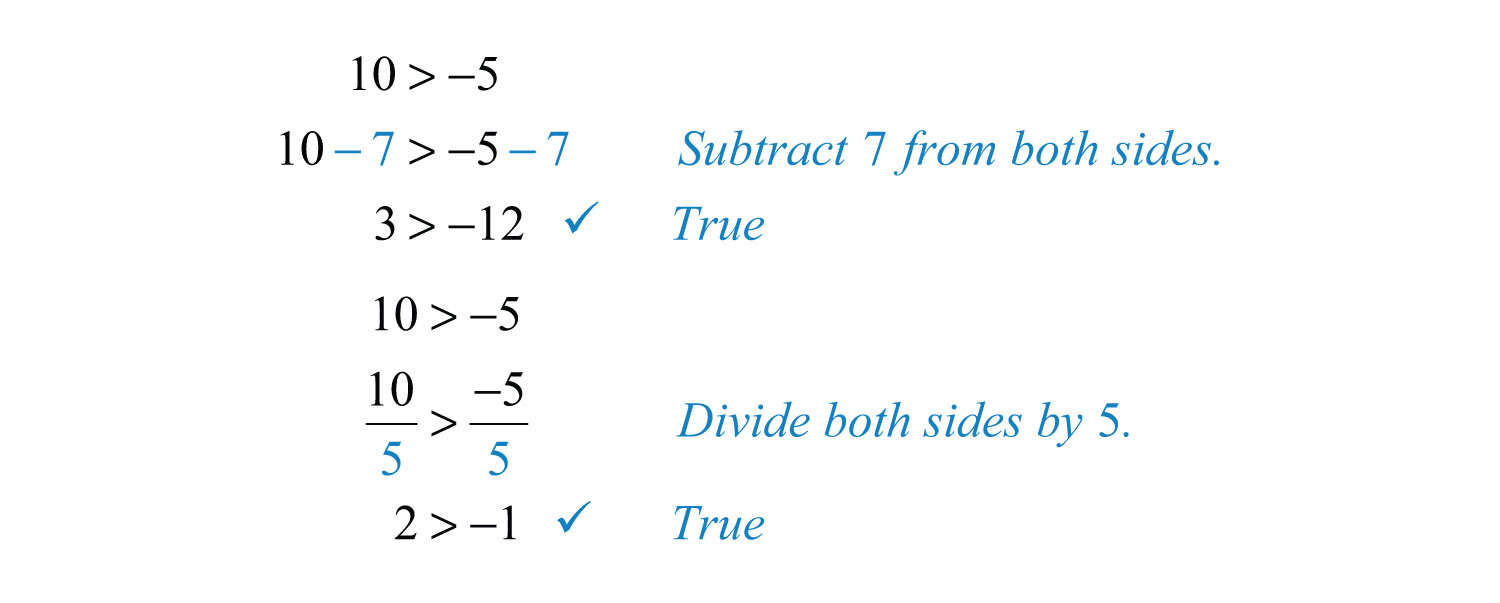
Both subtracting 7 from each side and dividing each side by +5 results in an equivalent inequality that is true.
Example 2: Solve and graph the solution set: .
Solution:


It is helpful to take a minute and choose a few values in and out of the solution set, substitute them into the original inequality, and then verify the results. As indicated, you should expect to solve the original inequality, but should not.

Checking in this manner gives a good indication that the inequality is solved correctly. This can be done mentally.
Answer: Interval notation:
When working with linear inequalities, a different rule applies when multiplying or dividing by a negative number. To illustrate the problem, consider the true statement and divide both sides by −5.

Dividing by −5 results in a false statement. To retain a true statement, the inequality must be reversed.

The same problem occurs when multiplying by a negative number. This leads to the following new rule: when multiplying or dividing by a negative number, reverse the inequality. It is easy to forget to do this so take special care to watch for negative coefficients.
In general, given algebraic expressions A and B, where c is a positive nonzero real number, we have the following properties of inequalitiesProperties used to obtain equivalent inequalities and used as a means to solve them.:
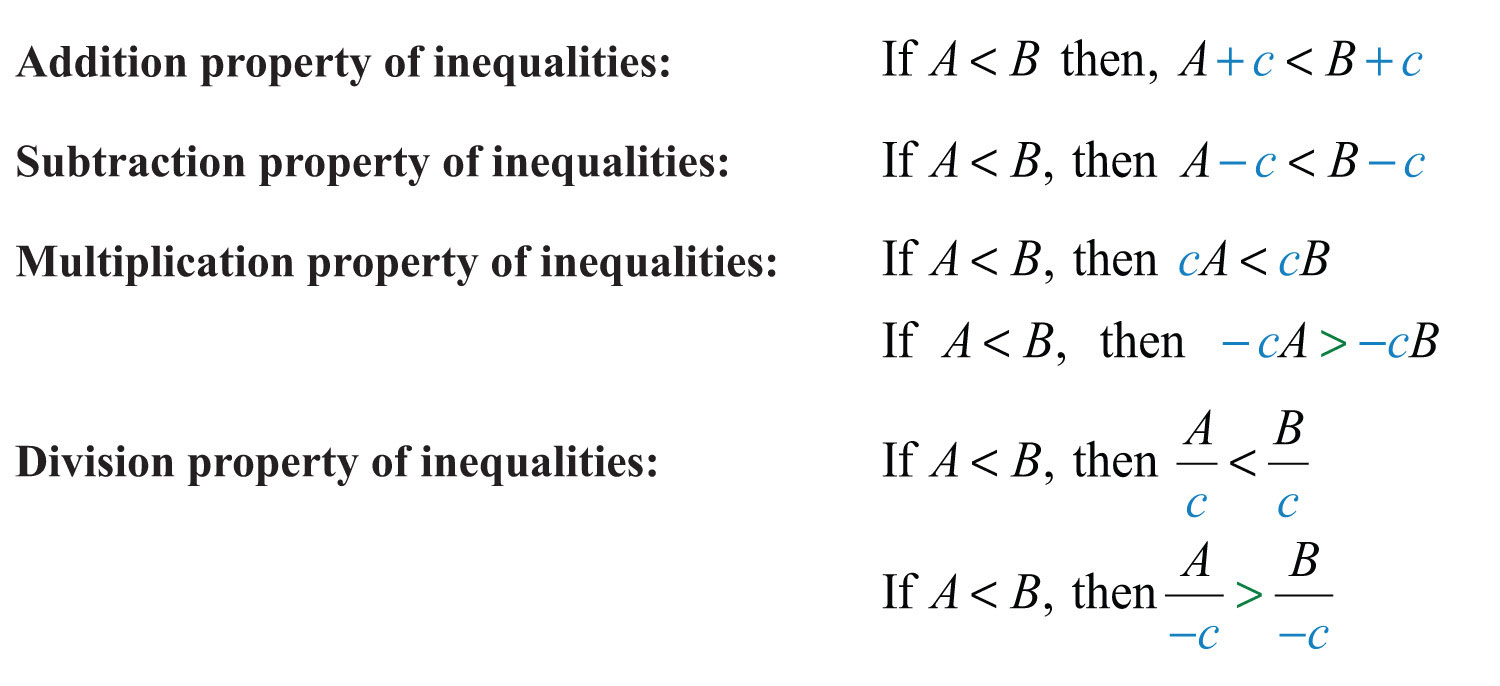
We use these properties to obtain an equivalent inequalityInequalities that share the same solution set., one with the same solution set, where the variable is isolated. The process is similar to solving linear equations.
Example 3: Solve: .
Solution:


Answer: Interval notation:
Example 4: Solve: .
Solution:
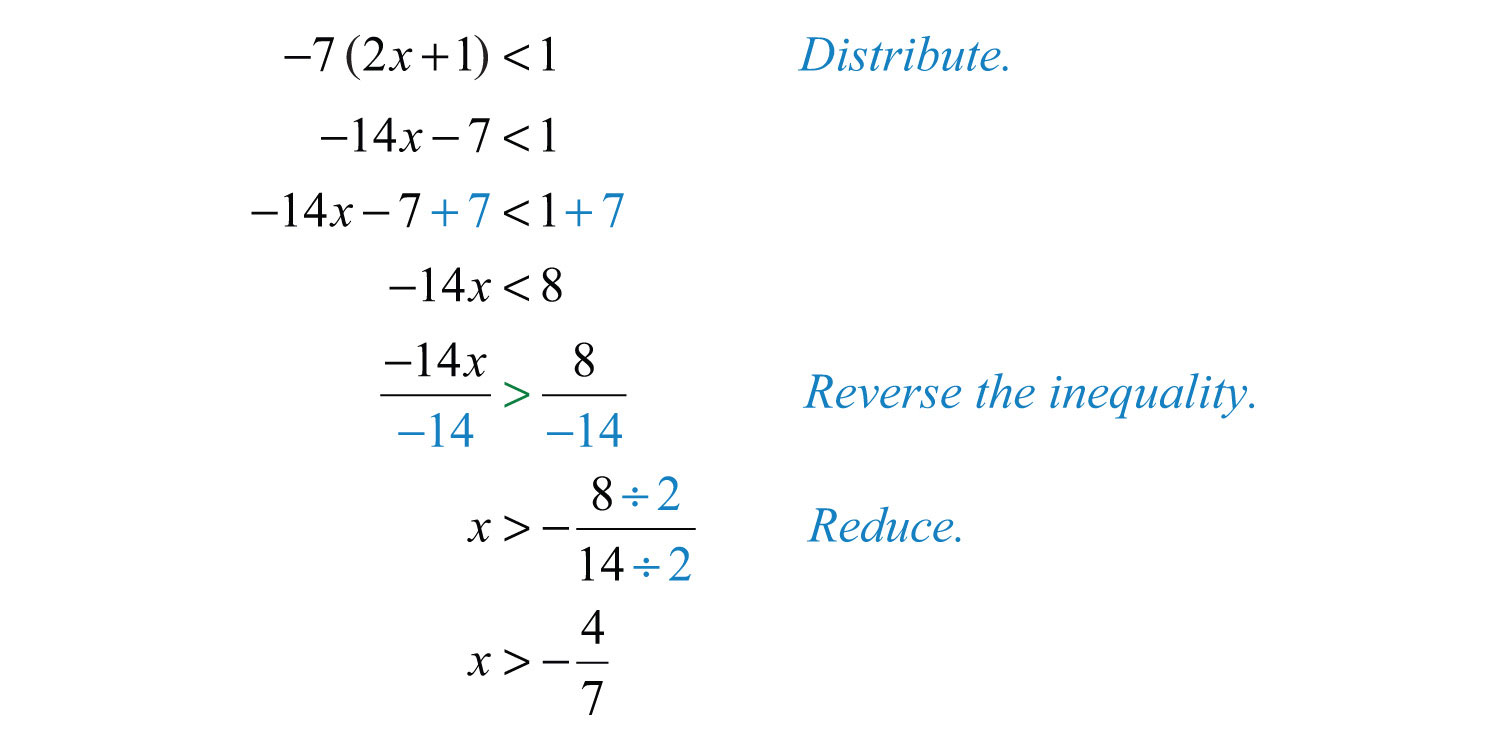

Answer: Interval notation:
Example 5: Solve: .
Solution:
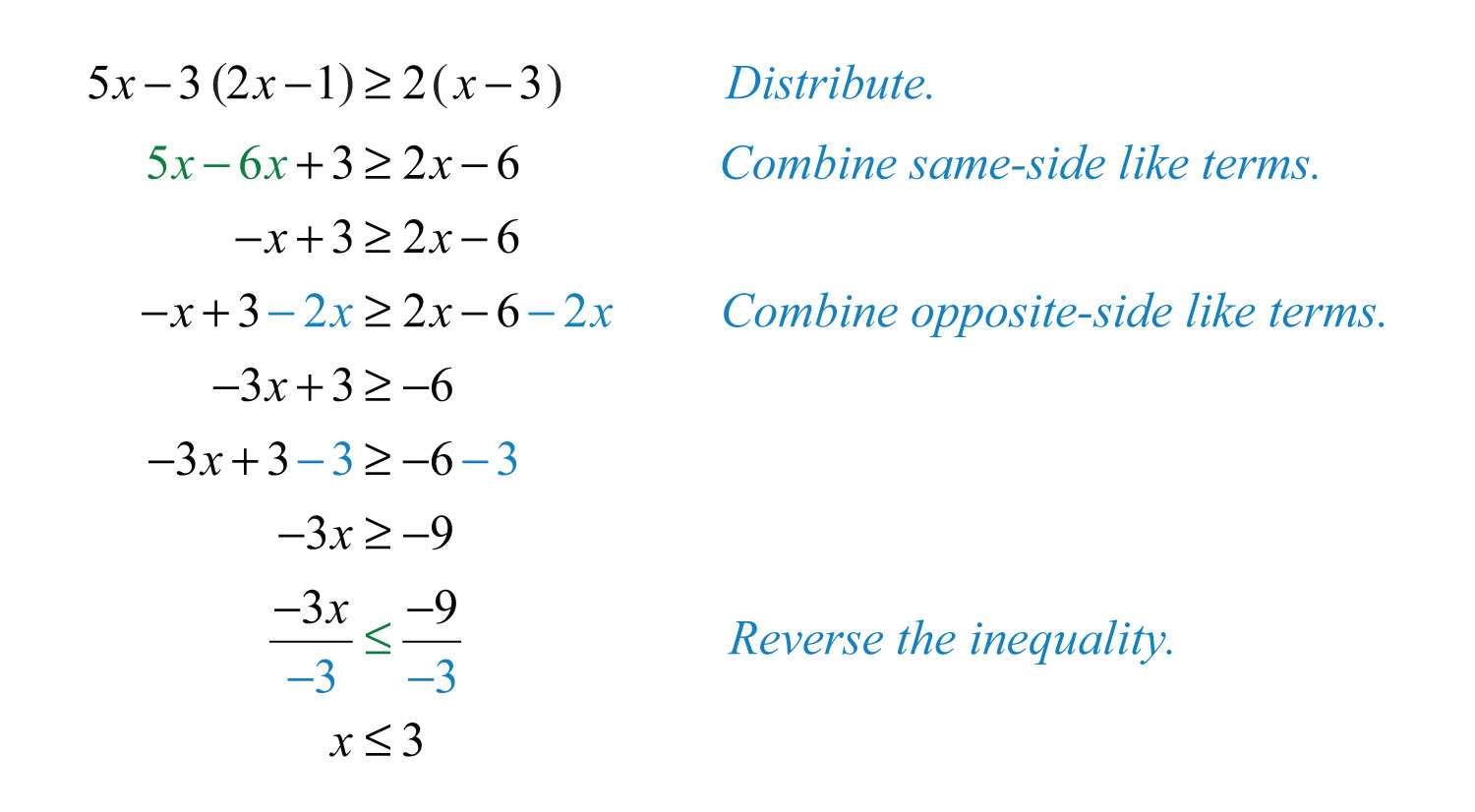

Answer: Interval notation:
Try this! Solve: .
Answer:
Video Solution
(click to see video)Compound Inequalities
Following are some examples of compound linear inequalities:

These compound inequalitiesTwo or more inequalities in one statement joined by the word “and” or by the word “or.” are actually two inequalities in one statement joined by the word “and” or by the word “or.” For example,

is a compound inequality because it can be decomposed as follows:

Solve each inequality individually, and the intersection of the two solution sets solves the original compound inequality. While this method works, there is another method that usually requires fewer steps. Apply the properties of this section to all three parts of the compound inequality with the goal of isolating the variable in the middle of the statement to determine the bounds of the solution set.
Example 6: Solve: .
Solution:


Answer: Interval notation:
Example 7: Solve: .
Solution:
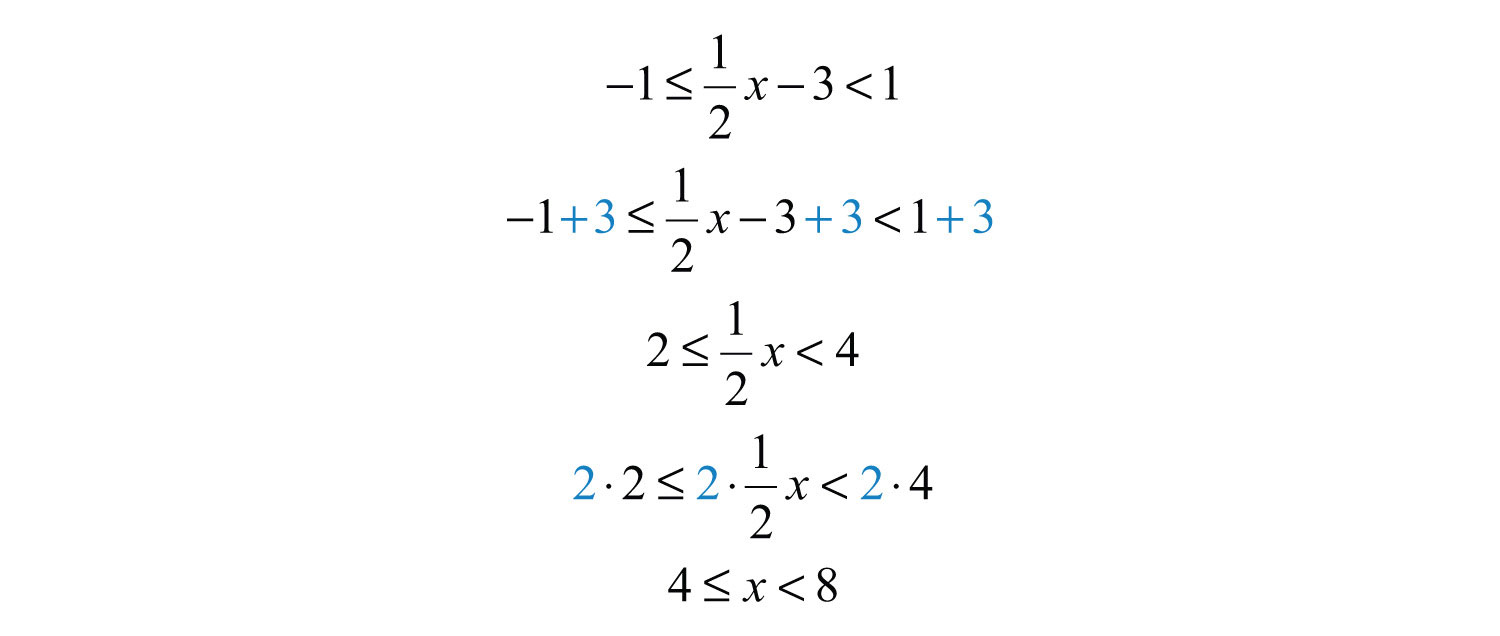

Answer: Interval notation:
It is important to note that when multiplying or dividing all three parts of a compound inequality by a negative number, you must reverse all of the inequalities in the statement. For example,

The answer above can be written in an equivalent form, where smaller numbers lie to the left and the larger numbers lie to the right, as they appear on a number line.

Using interval notation, write .
Try this! Solve: .
Answer:
Video Solution
(click to see video)For compound inequalities with the word “or” you must work both inequalities separately and then consider the union of the solution sets. Values in this union solve either inequality.
Example 8: Solve:
Solution: Solve each inequality and form the union by combining the solution sets.


Answer: Interval notation:
Try this! Solve: .
Answer:
Video Solution
(click to see video)Applications of Linear Inequalities
Some of the key words and phrases that indicate inequalities are summarized below:
| Key Phrases | Translation |
|---|---|
| A number is at least 5. | |
| A number is 5 or more inclusive. | |
| A number is at most 3. | |
| A number is 3 or less inclusive. | |
| A number is strictly less than 4. | |
| A number is less than 4, noninclusive. | |
| A number is greater than 7. | |
| A number is more than 7, noninclusive. | |
| A number is in between 2 and 10. | |
| A number is at least 5 and at most 15. | |
| A number may range from 5 to 15. |
As with all applications, carefully read the problem several times and look for key words and phrases. Identify the unknowns and assign variables. Next, translate the wording into a mathematical inequality. Finally, use the properties you have learned to solve the inequality and express the solution graphically or in interval notation.
Example 9: Translate: Five less than twice a number is at most 25.
Solution: First, choose a variable for the unknown number and identify the key words and phrases.

Answer: . The key phrase “is at most” indicates that the quantity has a maximum value of 25 or smaller.
Example 10: The temperature in the desert can range from 10°C to 45°C in one 24-hour period. Find the equivalent range in degrees Fahrenheit, F, given that .
Solution: Set up a compound inequality where the temperature in Celsius is inclusively between 10°C and 45°C. Then substitute the expression equivalent to the Celsius temperature in the inequality and solve for F.
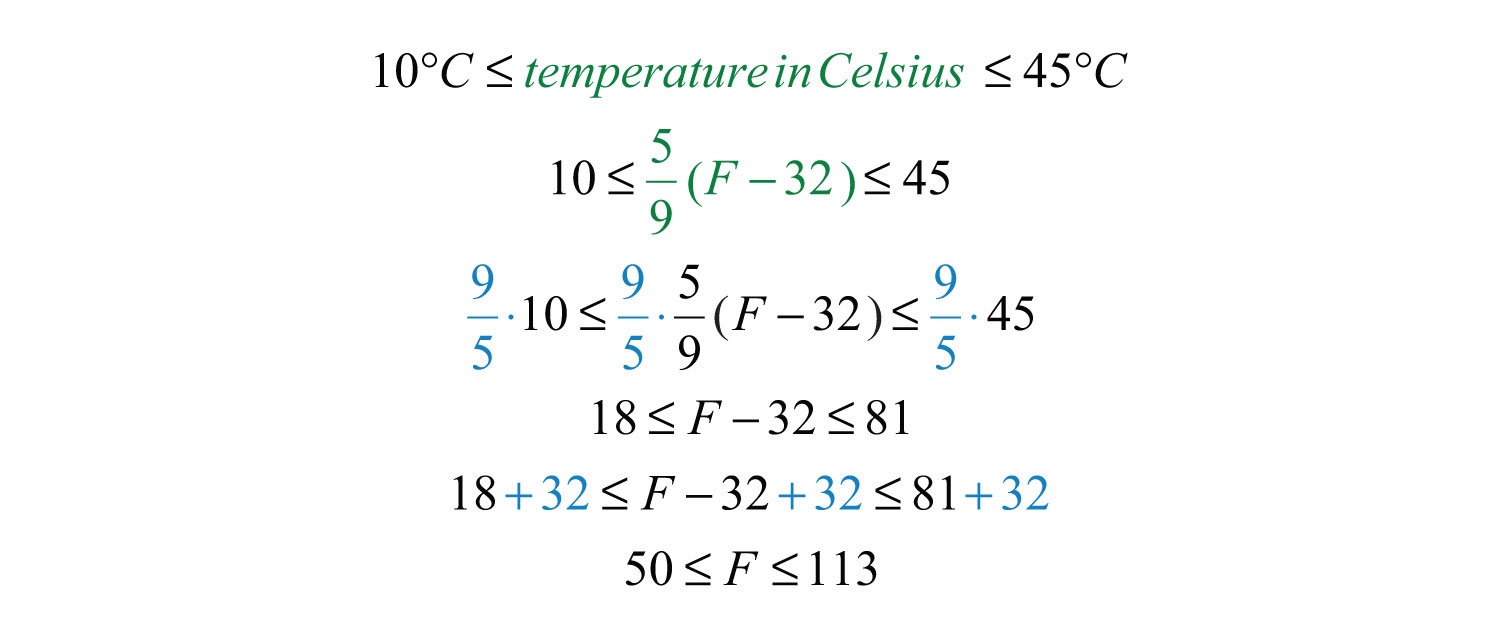
Answer: The equivalent Fahrenheit range is from 50°F to 113°F.
Example 11: In the first four events of a meet, a gymnast scores 7.5, 8.2, 8.5, and 9.0. What must she score on the fifth event to average at least 8.5?
Solution: The average must be at least 8.5; this means that the average must be greater than or equal to 8.5.
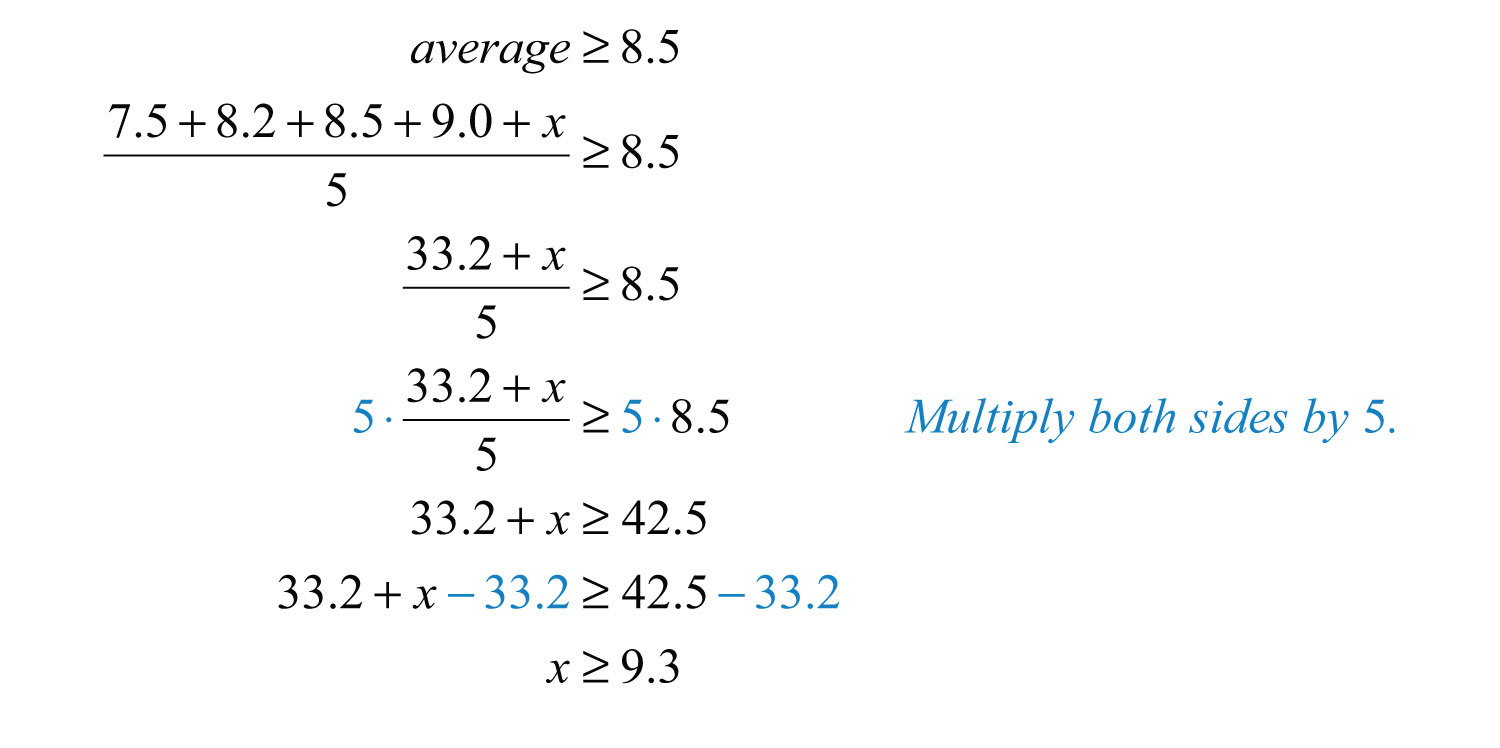
Answer: She must score at least 9.3 on the fifth event.
Key Takeaways
- Inequalities typically have infinitely many solutions. The solutions are presented graphically on a number line or using interval notation or both.
- All but one of the rules for solving linear inequalities are the same as for solving linear equations. If you divide or multiply an inequality by a negative number, reverse the inequality to obtain an equivalent inequality.
- Compound inequalities involving the word “or” require us to solve each inequality and form the union of each solution set. These are the values that solve at least one of the given inequalities.
- Compound inequalities involving the word “and” require the intersection of the solution sets for each inequality. These are the values that solve both or all of the given inequalities.
- The general guidelines for solving word problems apply to applications involving inequalities. Be aware of a new list of key words and phrases that indicate a mathematical setup involving inequalities.
Topic Exercises
Part A: Checking for Solutions
Determine whether the given number is a solution to the given inequality.
1.
2.
3.
4.
5.
6.
7. ;
8.
9. ;
10. ;
Part B: Solving Linear Inequalities
Solve and graph the solution set. In addition, present the solution set in interval notation.
11.
12.
13.
14.
15.
16.
17.
18.
19.
20.
21.
22.
23.
24.
25.
26.
27.
28.
29.
30.
31.
32.
33.
34.
35.
36.
37.
38.
39.
40.
41.
42.
Set up an algebraic inequality and then solve it.
43. The sum of three times a number and 4 is greater than negative 8.
44. The sum of 7 and three times a number is less than or equal to 1.
45. When a number is subtracted from 10, the result is at most 12.
46. When 5 times a number is subtracted from 6, the result is at least 26.
47. If five is added to three times a number, then the result is less than twenty.
48. If three is subtracted from two times a number, then the result is greater than or equal to nine.
49. Bill earns $12.00 for the day plus $0.25 for every person he gets to register to vote. How many people must he register to earn at least $50.00 for the day?
50. With a golf club membership costing $100 per month, each round of golf costs only $25.00. How many rounds of golf can a member play if he wishes to keep his costs to $250 per month at most?
51. Joe earned scores of 72, 85, and 75 on his first three algebra exams. What must he score on the fourth exam to average at least 80?
52. Maurice earned 4, 7, and 9 points out of 10 on the first three quizzes. What must he score on the fourth quiz to average at least 7?
53. A computer is set to shut down if the temperature exceeds 40°C. Give an equivalent statement using degrees Fahrenheit. (Hint: .)
54. A certain brand of makeup is guaranteed not to run if the temperature is less than 35°C. Give an equivalent statement using degrees Fahrenheit.
Part C: Compound Inequalities
Solve and graph the solution set. In addition, present the solution set in interval notation.
55.
56.
57.
58.
59.
60.
61.
62.
63.
64.
65.
66.
67.
68.
69.
70.
71.
72.
73.
74.
75.
76.
77.
78.
79.
80.
81.
82.
83.
84.
85.
86.
87.
88.
Set up a compound inequality for the following and then solve.
89. Five more than two times some number is between 15 and 25.
90. Four subtracted from three times some number is between −4 and 14.
91. Clint wishes to earn a B, which is at least 80 but less than 90. What range must he score on the fourth exam if the first three were 65, 75, and 90?
92. A certain antifreeze is effective for a temperature range of −35°C to 120°C. Find the equivalent range in degrees Fahrenheit.
93. The average temperature in London ranges from 23°C in the summer to 14°C in the winter. Find the equivalent range in degrees Fahrenheit.
94. If the base of a triangle measures 5 inches, then in what range must the height be for the area to be between 10 square inches and 20 square inches?
95. A rectangle has a length of 7 inches. Find all possible widths if the area is to be at least 14 square inches and at most 28 square inches.
96. A rectangle has a width of 3 centimeters. Find all possible lengths, if the perimeter must be at least 12 centimeters and at most 26 centimeters.
97. The perimeter of a square must be between 40 feet and 200 feet. Find the length of all possible sides that satisfy this condition.
98. If two times an angle is between 180 degrees and 270 degrees, then what are the bounds of the original angle?
99. If three times an angle is between 270 degrees and 360 degrees then what are the bounds of the original angle?
Part D: Discussion Board Topics
100. Research and discuss the use of set-builder notation with intersections and unions.
101. Can we combine logical “or” into one statement like we do for logical “and”?
Answers
1: Yes
3: No
5: Yes
7: Yes
9: Yes
11: ;

13: ;

15: ;

17: ;

19: ;

21: ;

23: ;

25: ;

27: ;

29: ;

31:

33: ;

35: ;

37: ;

39: R

41: ;

43:
45:
47:
49: Bill must register at least 152 people.
51: Joe must earn at least an 88 on the fourth exam.
53: The computer will shut down when the temperature exceeds 104°F.
55: ;

57: ;

59: ;

61: ;

63: ;

65: ;

67: ;

69: ;

71: ;

73: ;

75: ;

77: R

79: ;

81: ;

83: ;

85: ;

87: ;

89:
91: Clint must earn a score in the range from 90 to 100.
93: The average temperature in London ranges from 57.2°F to 73.4°F.
95: The width must be at least 2 inches and at most 4 inches.
97: Sides must be between 10 feet and 50 feet.
99: The angle is between 90 degrees and 120 degrees.
2.9 Review Exercises and Sample Exam
Review Exercises
Introduction to Algebra
Evaluate.
1. , where
2. , where
3. , where
4. , where
5. , where , , and
6. , where , , and
7. , where
8. , where
9. Calculate the simple interest earned on a 3-year investment of $750 at an annual interest rate of 8%.
10. A bus traveled for hours at an average speed of 48 miles per hour. What distance did the bus travel?
11. Calculate the area of a rectangle with dimensions 4½ feet by 6 feet.
12. Calculate the volume of a rectangular box with dimensions 4½ feet by 6 feet by 1 foot.
Simplifying Algebraic Expressions
Multiply.
13.
14.
15.
16.
17.
18.
Simplify.
19.
20.
21.
22.
23.
24.
25.
26.
27.
28.
29.
30.
31. Subtract from .
32. Subtract from twice the quantity .
Solving Linear Equations: Part I
Is the given value a solution to the linear equation?
33. ;
34. ;
35. ;
36. ;
Solve.
37.
38.
39.
40.
41.
42.
43.
44.
45.
46.
47.
48.
49.
50.
51. The sum of 9x and 6 is 51.
52. The difference of 3x and 8 is 25.
Solving Linear Equations: Part II
Solve.
53.
54.
55.
56.
57.
58.
59.
60.
61.
62.
63.
64.
65.
66.
67.
68.
69. The sum of 4x and 3 is equal to the difference of 7x and 8.
70. The difference of 5x and 1 is equal to the sum of 12x and 1.
71. Solve for x:
72. Solve for y:
73. Solve for l:
74. Solve for b:
Applications of Linear Equations
75. A larger integer is 3 more than twice a smaller integer. If their sum is 39, then find the integers.
76. A larger integer is 5 more than 3 times a smaller integer. If their sum is 49, then find the integers.
77. The sum of three consecutive odd integers is 45. Find the integers.
78. The sum of three consecutive even integers is 72. Find the integers.
79. The sum of three consecutive integers is 60. Find the integers.
80. The length of a rectangle is 7 centimeters less than twice its width. If the perimeter measures 46 centimeters, then find the dimensions of the rectangle.
81. A triangle has sides whose measures are consecutive even integers. If the perimeter is 24 meters, then find the measure of each side.
82. The circumference of a circle measures 24π inches. Find the radius of the circle.
83. Mary invested $1,800 in two different accounts. One account earned 3.5% simple interest and the other earned 4.8%. If the total interest after 1 year was $79.25, then how much did she invest in each account?
84. James has $6 in dimes and quarters. If he has 4 fewer quarters than he does dimes, then how many of each coin does he have?
85. Two brothers leave the house at the same time traveling in opposite directions. One averages 40 miles per hour and the other 36 miles per hour. How long does it take for the distance between them to reach 114 miles?
86. Driving to her grandmother’s house, Jill made several stops and was only able to average 40 miles per hour. The return trip took 2 hours less time because she drove nonstop and was able to average 60 miles per hour. How long did it take Jill to drive home from her grandmother’s house?
Ratio and Proportion Applications
Solve.
87.
88.
89.
90.
91.
92.
93.
94.
95. Find two numbers in the proportion 4 to 5 whose sum is 27.
96. A larger number is 2 less than twice a smaller number. If the two numbers are in the proportion 5 to 9, then find the numbers.
97. A recipe calls for 1½ teaspoons of vanilla extract for every 3 cups of batter. How many teaspoons of vanilla extract should be used with 7 cups of batter?
98. The ratio of female to male employees at a certain bank is 4 to 5. If there are 80 female employees at the bank, then determine the total number of employees.
If triangle ABC is similar to triangle RST, then find the remaining two sides given the following.
99. , , , and
100. , , , and
101. At the same time of day, a pole casts a 27-foot shadow and 4-foot boy casts a 6-foot shadow. Calculate the height of the pole.
102. An equilateral triangle with sides measuring 10 units is similar to another equilateral triangle with scale factor of 2:3. Find the perimeter of the unknown triangle.
Introduction to Inequalities and Interval Notation
Graph all solutions on a number line and provide the corresponding interval notation.
103.
104.
105.
106.
107.
108.
109.
110.
Determine the inequality given the answers expressed in interval notation.
111.
112.
113.
114.
115.
116.
Linear Inequalities (One Variable)
Solve and graph. In addition, present the solution set in interval notation.
117.
118.
119.
120.
121.
122.
123.
124.
125.
126.
127.
128.
129.
130.
Sample Exam
1. Evaluate , where , , and .
2. Determine the area of a triangle given that the base measures 10 centimeters and the height measures 5 centimeters. ()
Simplify.
3.
4.
5.
6.
Solve.
7.
8.
9.
10.
11.
12.
13.
14. Solve for b: .
Solve and graph the solution set. In addition, present the solution set in interval notation.
15.
16.
17.
18.
19.
20. An algebra student earns 75, 79, and 89 points on the first three quizzes. What must she score on the fourth quiz to earn an average of at least 80?
21. The sum of three consecutive odd integers is 117. Find the integers.
22. The length of a rectangle is 6 inches less than twice the width. If the perimeter measures 39 inches, then find the dimensions of the rectangle.
23. Millie invested her $5,350 savings in two accounts. One account earns 5% annual interest and the other earns 6.2% in annual interest. If she earned $317.30 simple interest in 1 year, then how much was in each account?
24. Because of traffic, Joe was only able to drive an average of 42 miles per hour on the trip to a conference. He was able to average 63 miles per hour on the return trip and it took 1 hour less time. How long did it take Joe to drive home from the conference?
25. A graphic designer wishes to crop an image in the width-to-height ratio of 3:2. If the height is required to be 400 pixels, then to how many pixels should the width be set?
Review Exercises Answers
1: −1
3: −1/10
5: −6
7: 24
9: $180
11: 27 square feet
13:
15:
17:
19:
21:
23:
25:
27:
29:
31:
33: No
35: Yes
37: 2
39: 32
41: −7
43: −3/7
45: 3
47: −21
49: 7/5
51: 5
53: 4
55: 12
57: 2
59: 3/8
61: Ø
63: 8
65: 7/8
67: R
69: 11/3
71:
73:
75: 12, 27
77: 13, 15, 17
79: 19, 20, 21
81: 6 meters, 8 meters, 10 meters
83: Mary invested $550 at 3.5% and $1,250 at 4.8%.
85: They will be 114 miles apart in 1½ hours.
87: 6
89: 11/5
91: 5/6
93: 2/3
95: 12, 15
97: 3½ teaspoons
99: t = 4, r = 4/3
101: 18 feet
103:

105:

107:

109:

111:
113:
115:
117: ;

119: ;

121: ;

123: ;

125: ;

127: ;

129: ;

Sample Exam Answers
1: 6
3:
5:
7: −5
9: 1
11: Ø
13: −3
15: ;

17: ;

19: ;

21: The three odd integers are 37, 39, and 41.
23: Millie invested $1,200 in the account earning 5% annual interest and $4,150 in the account earning 6.2%.
25: The width should be set to 600 pixels.




